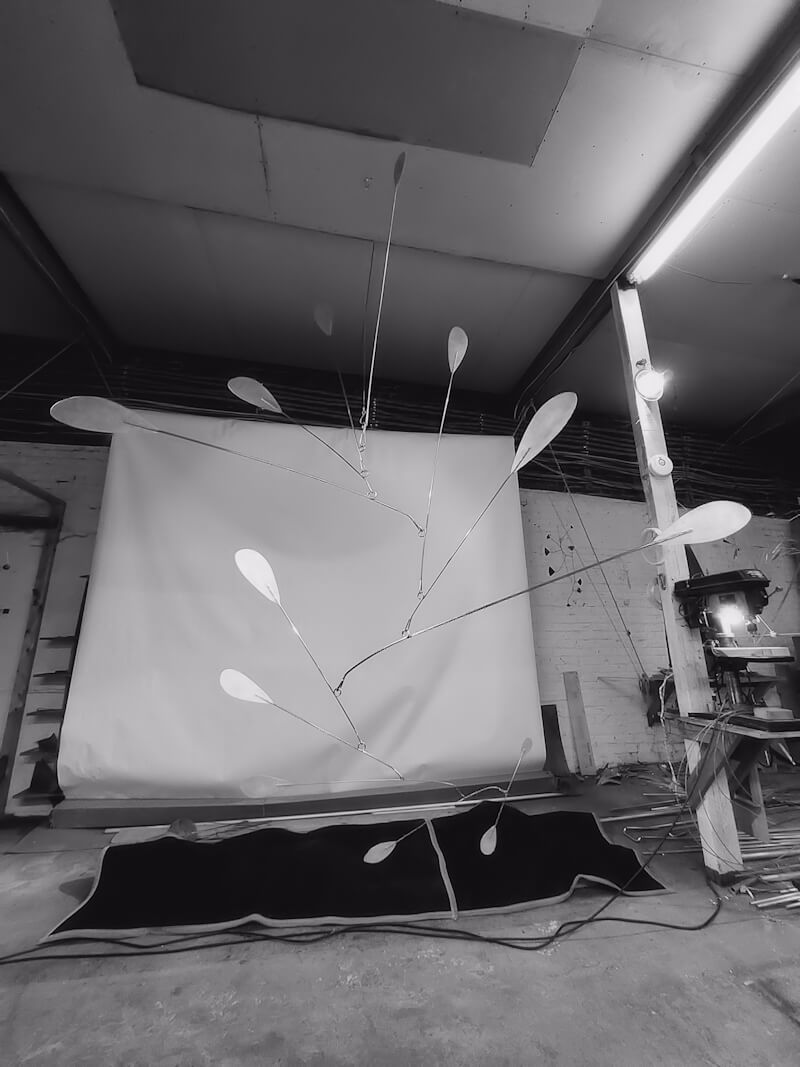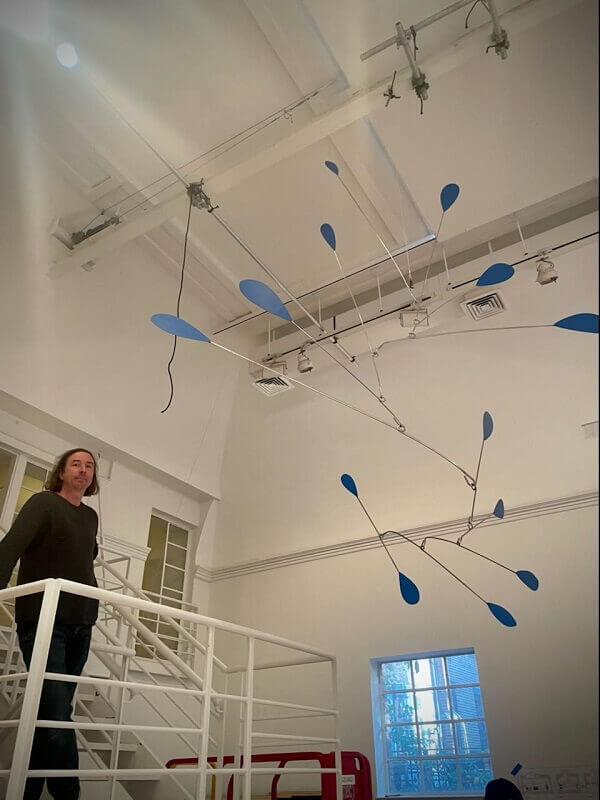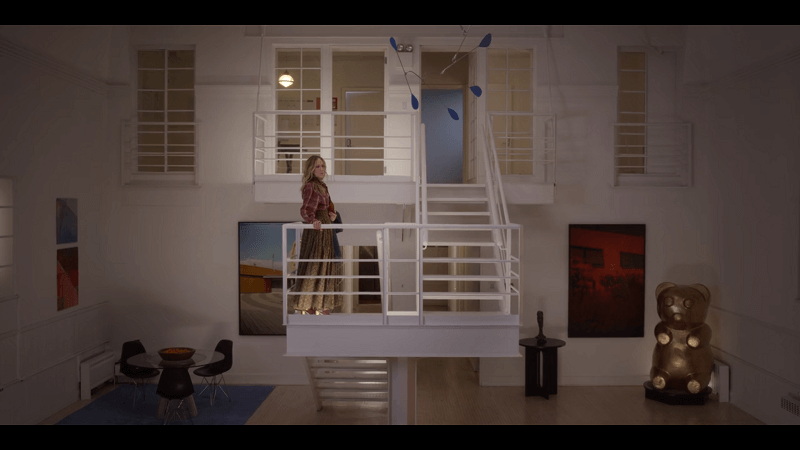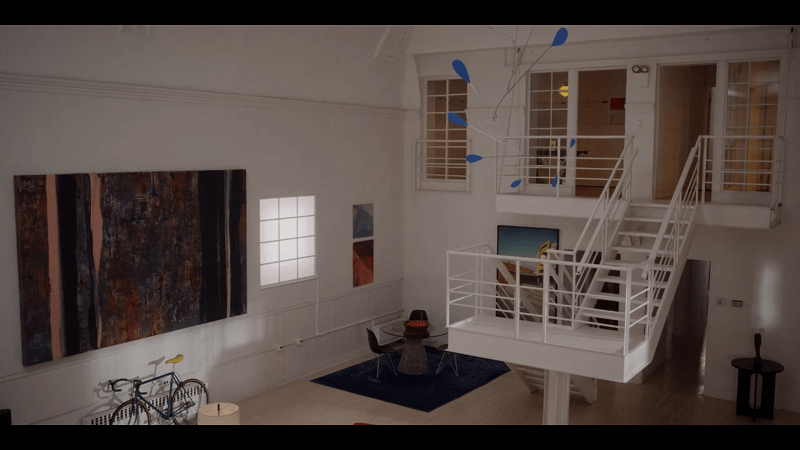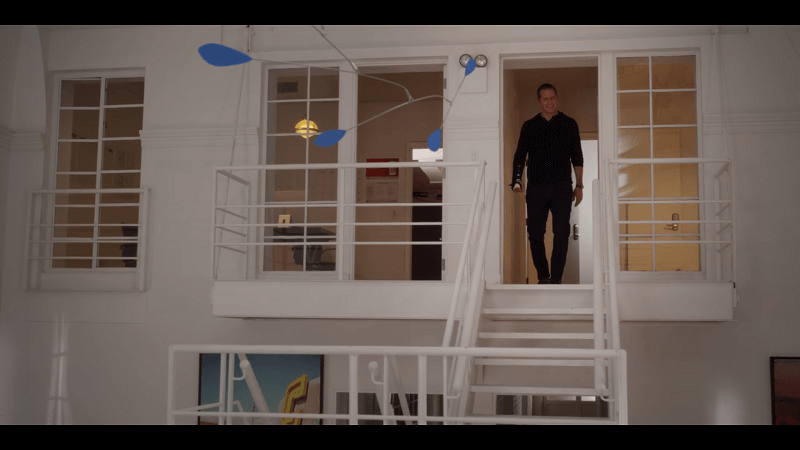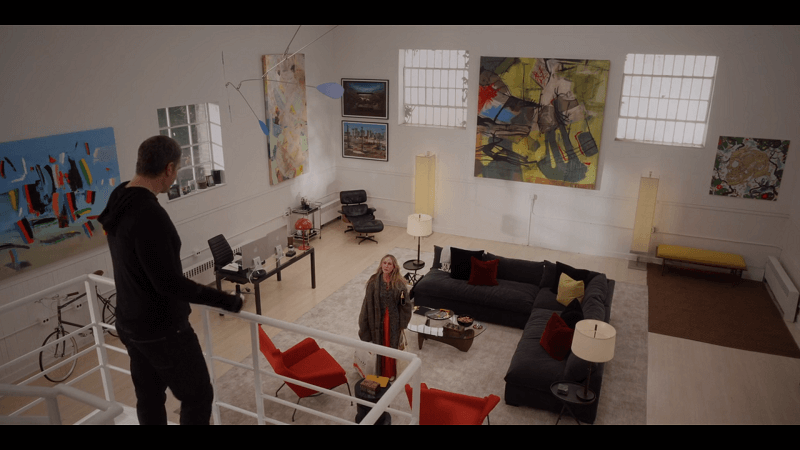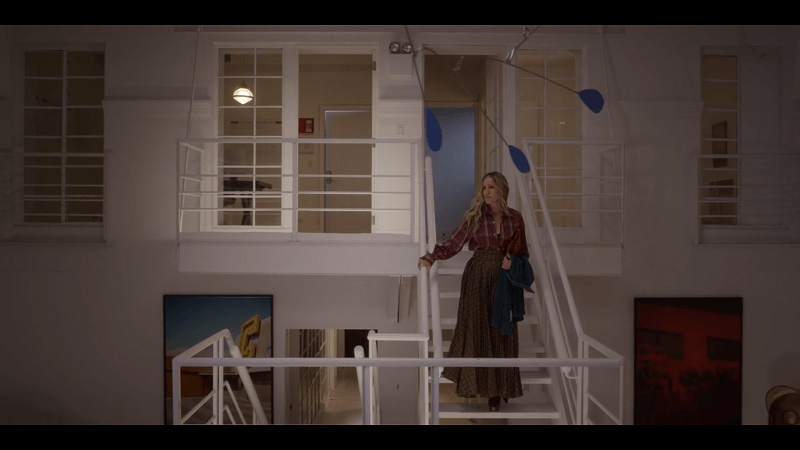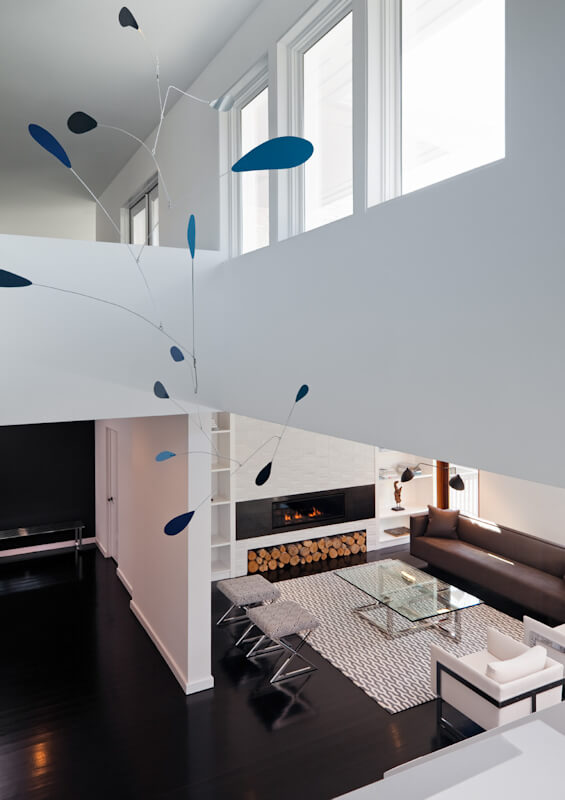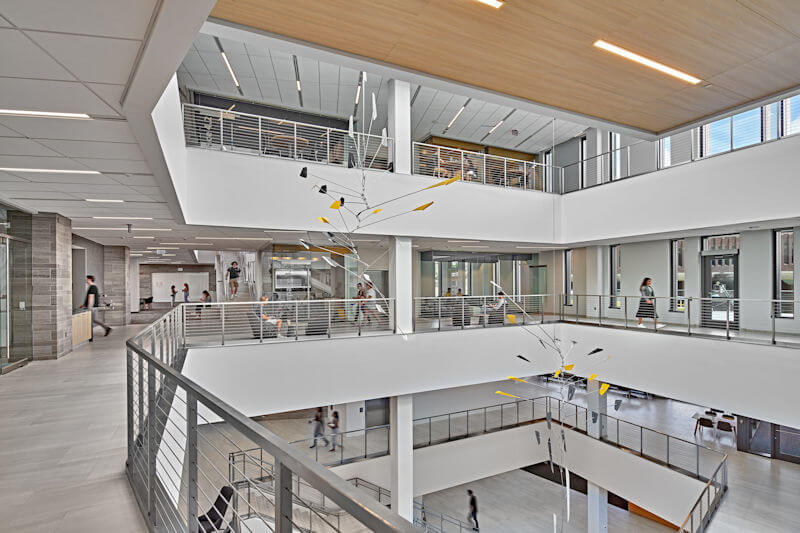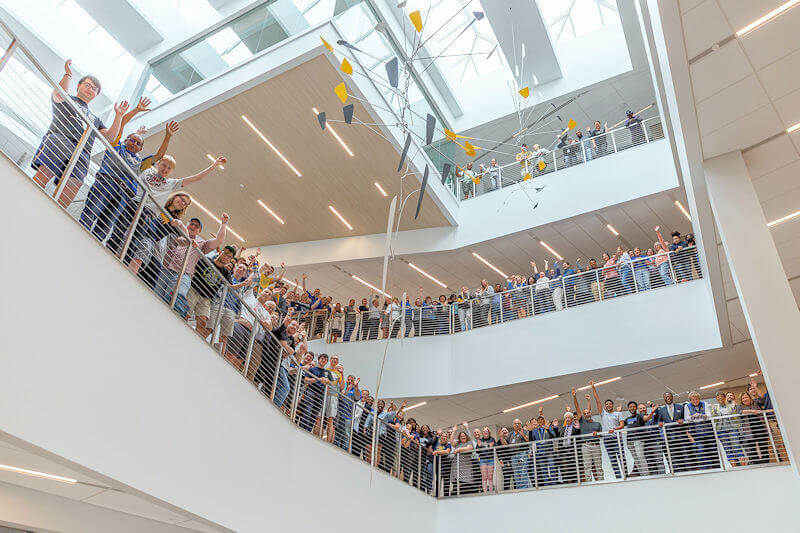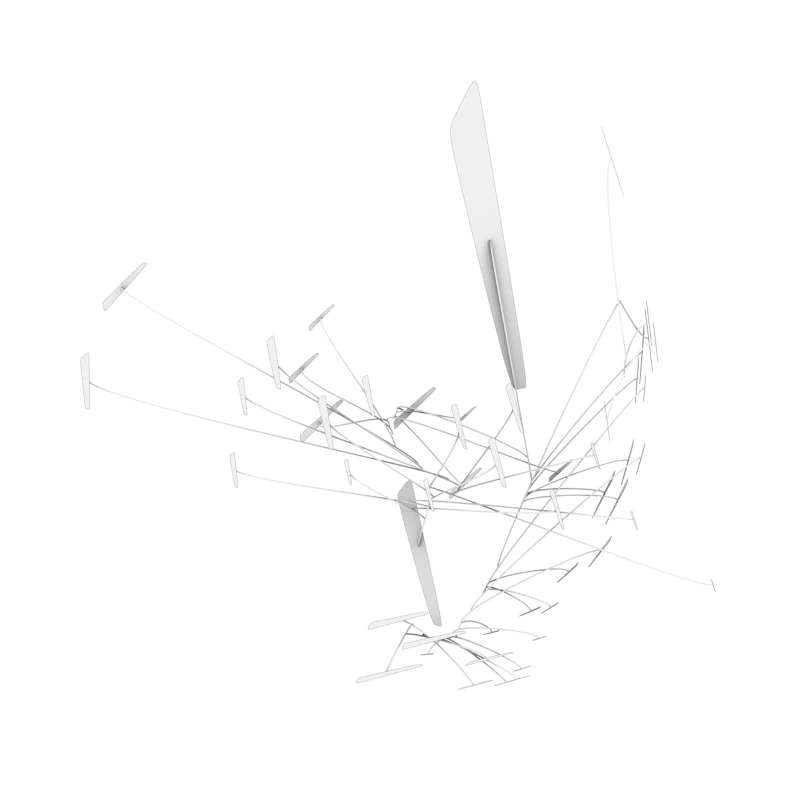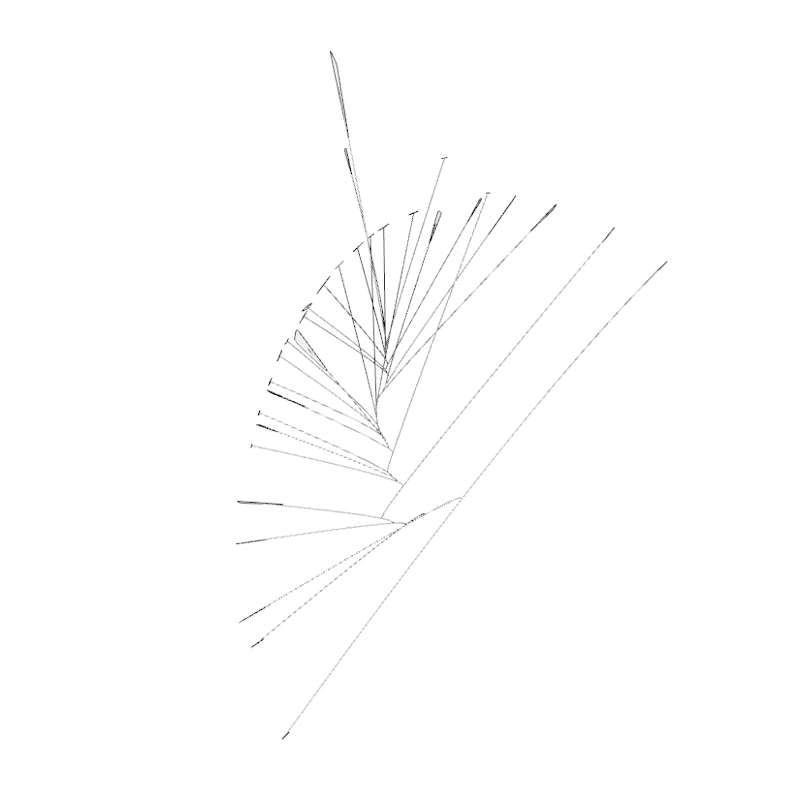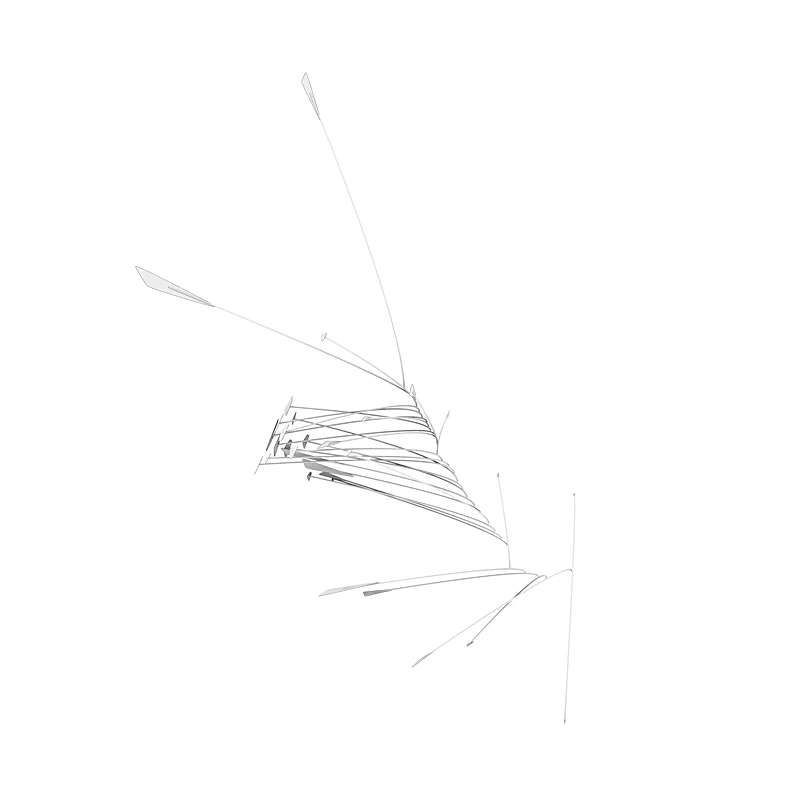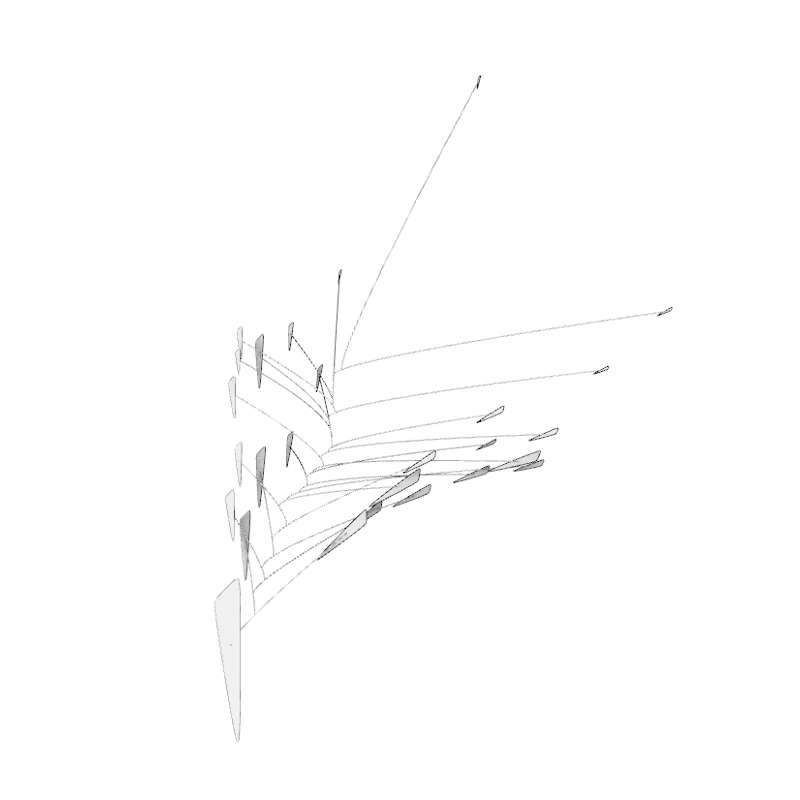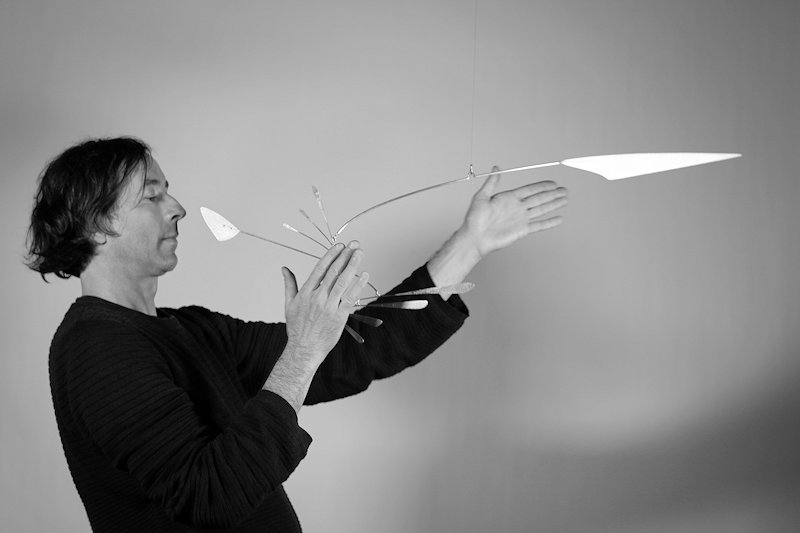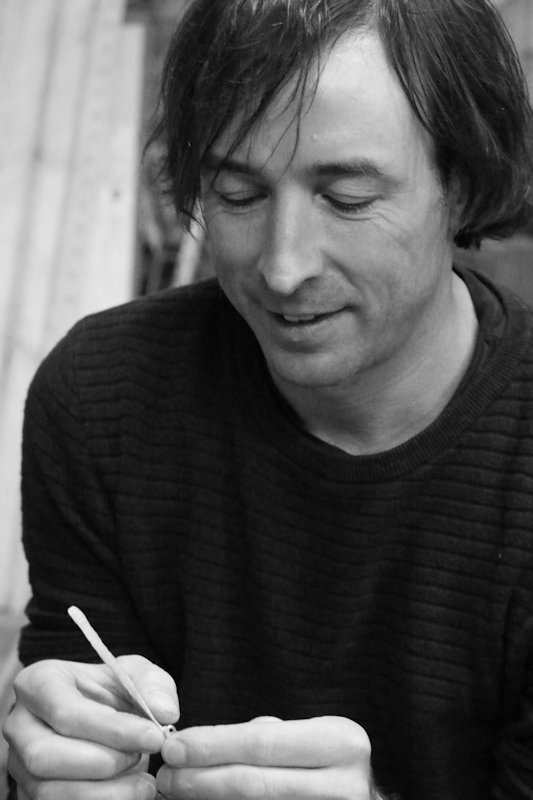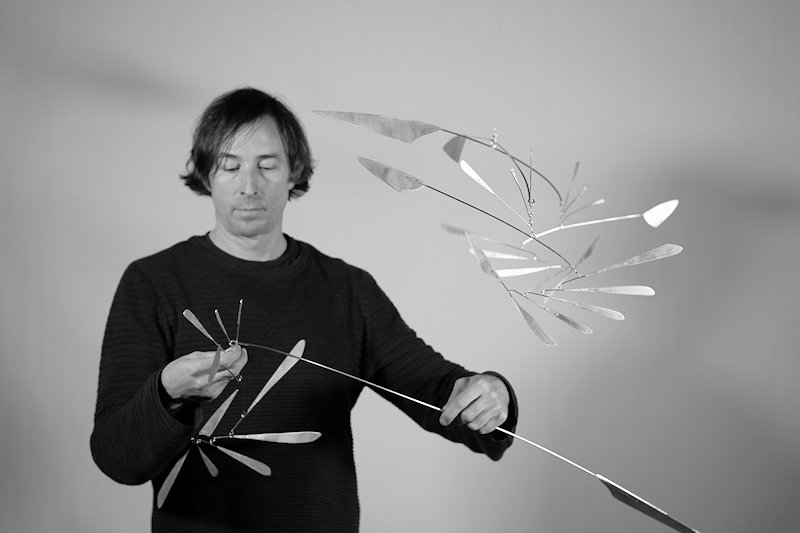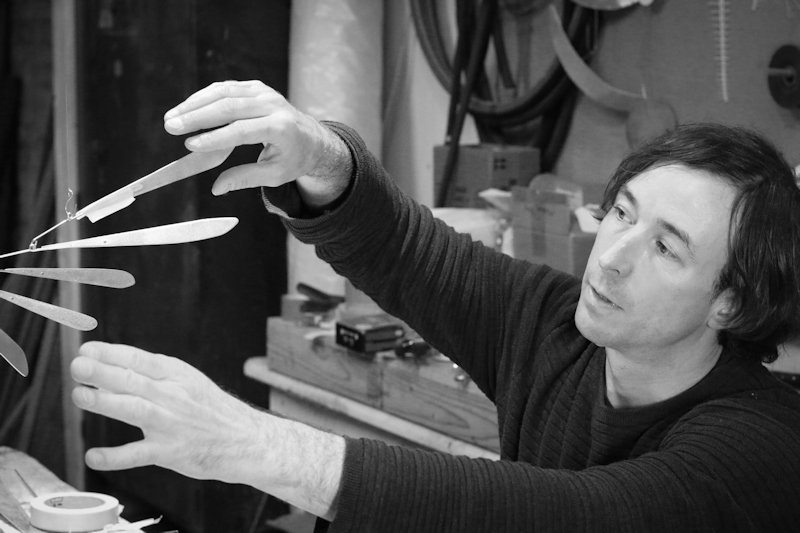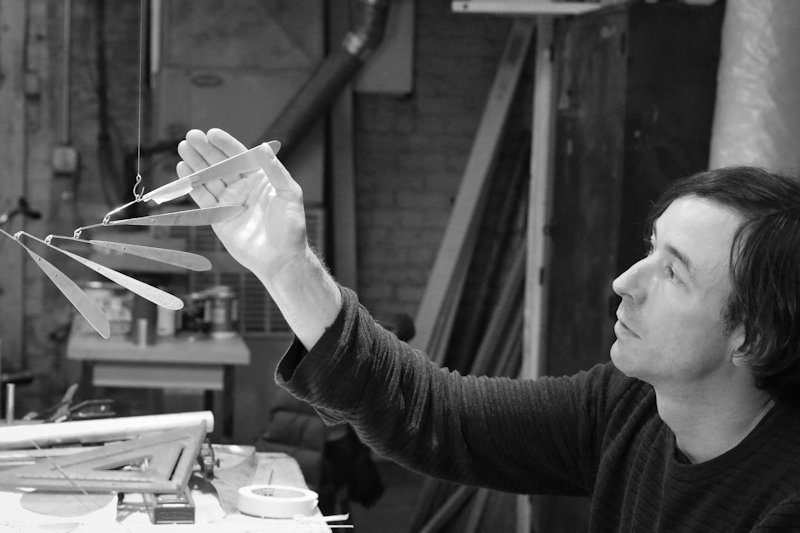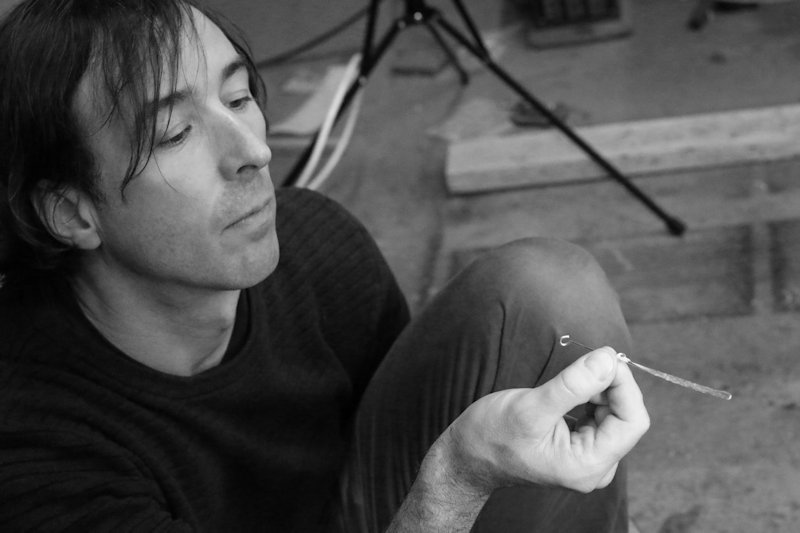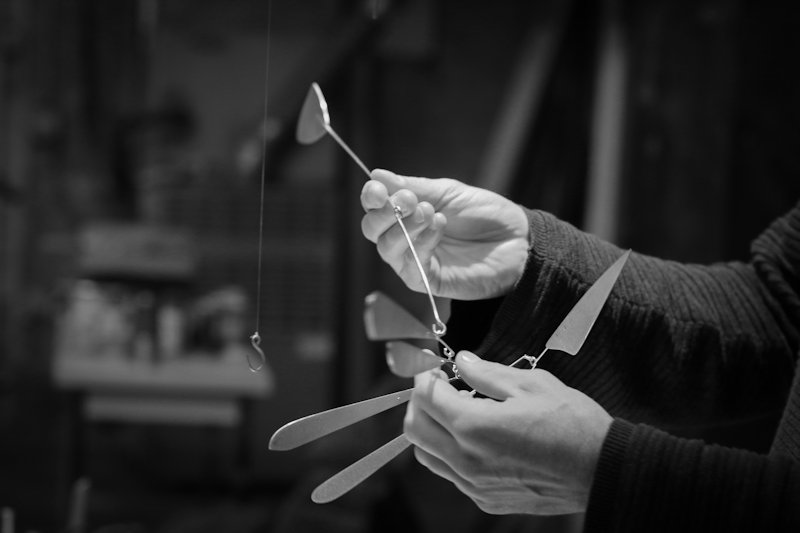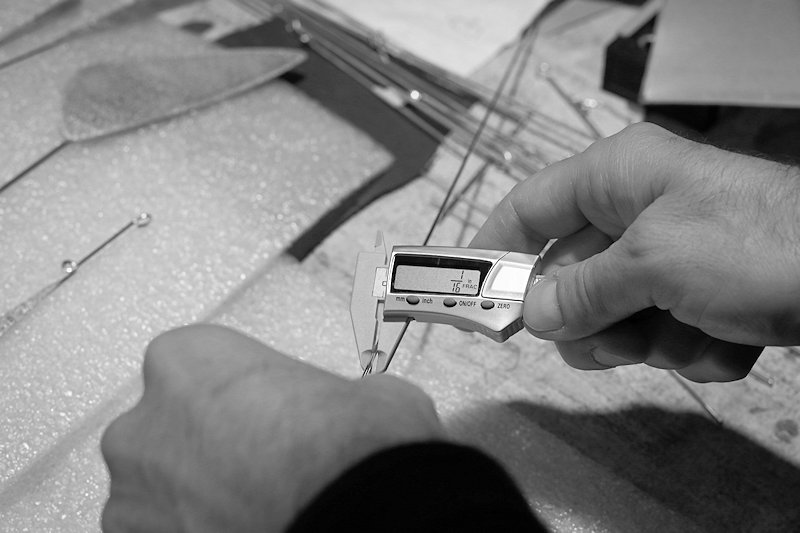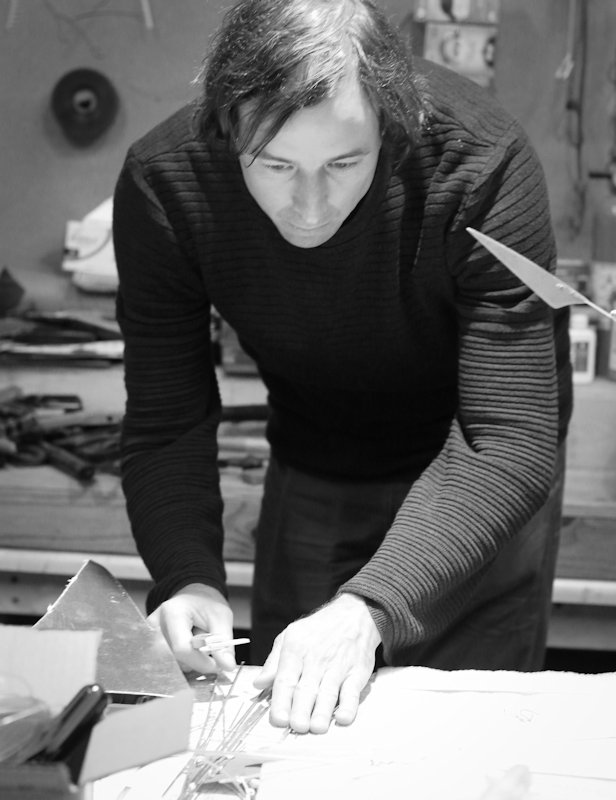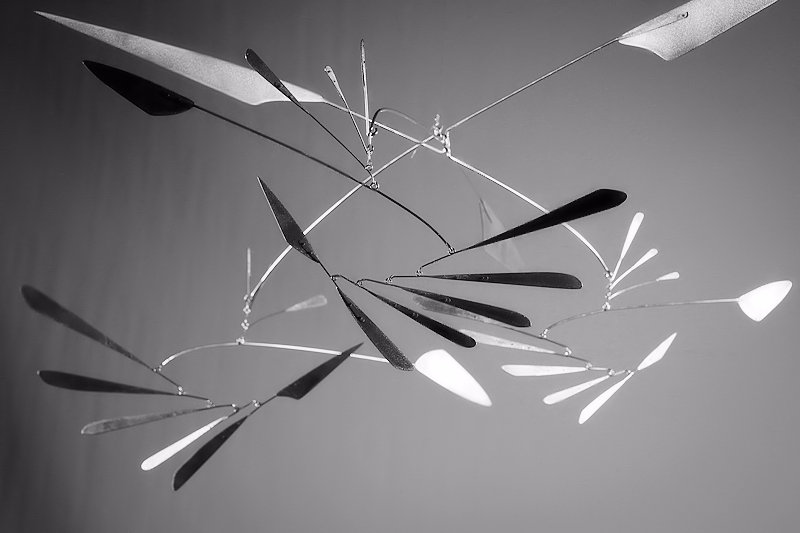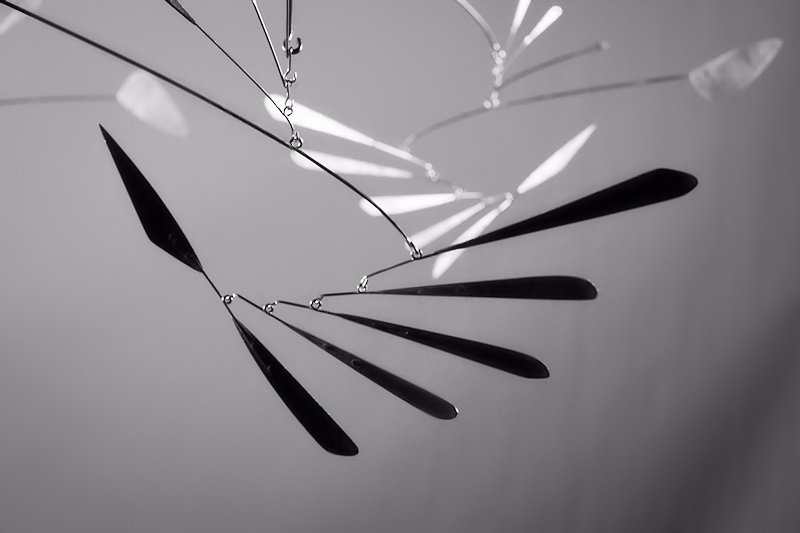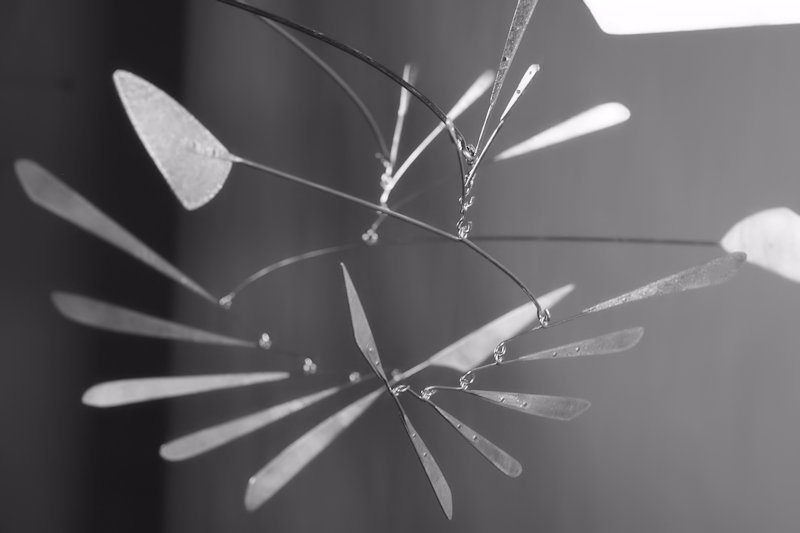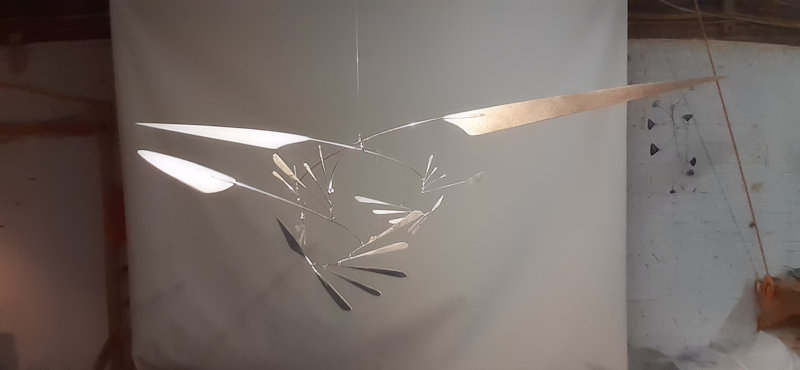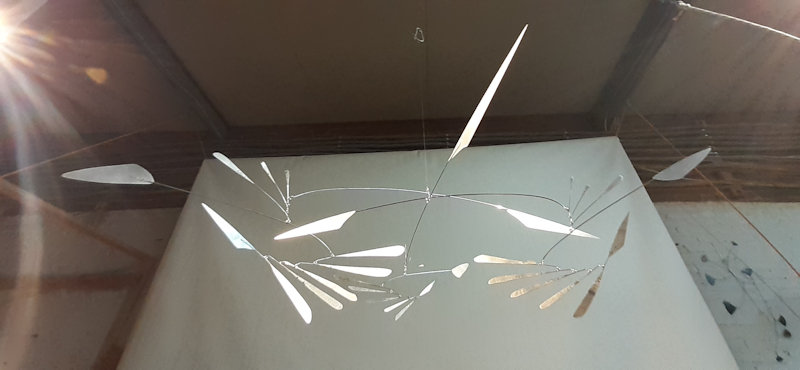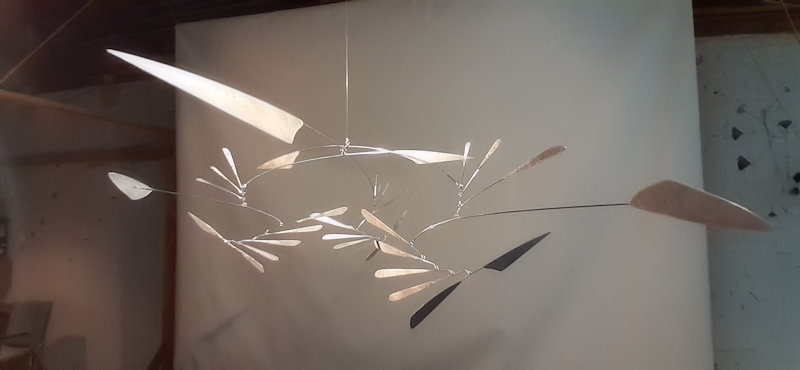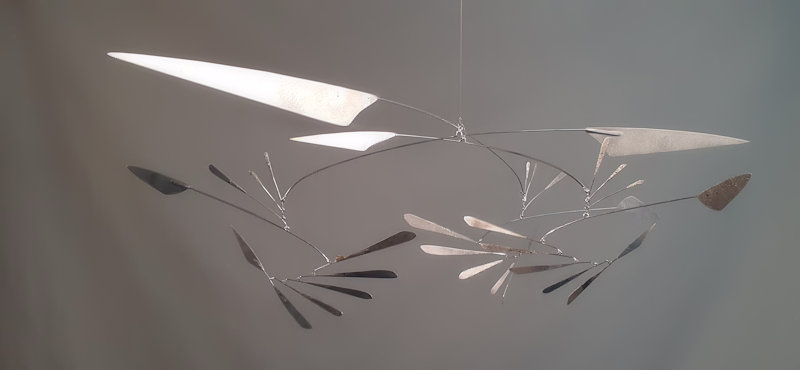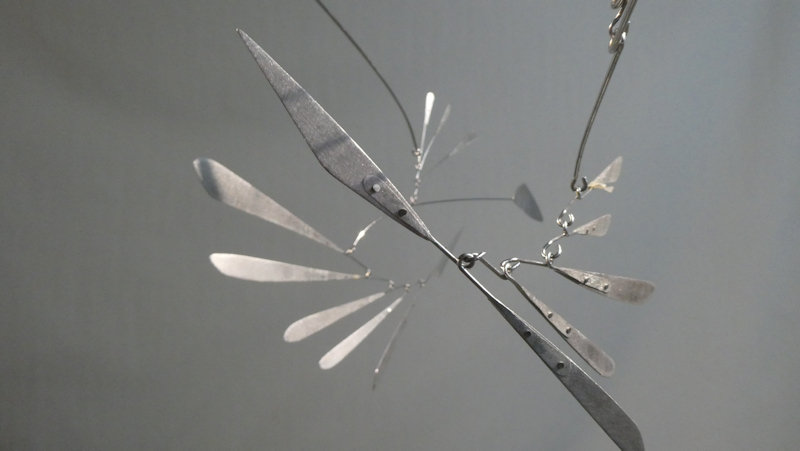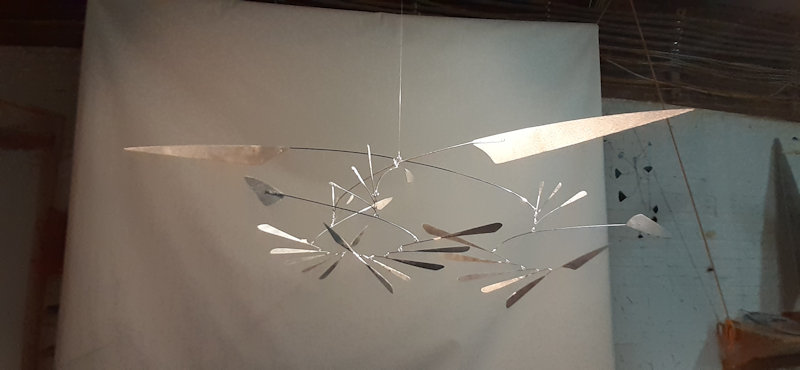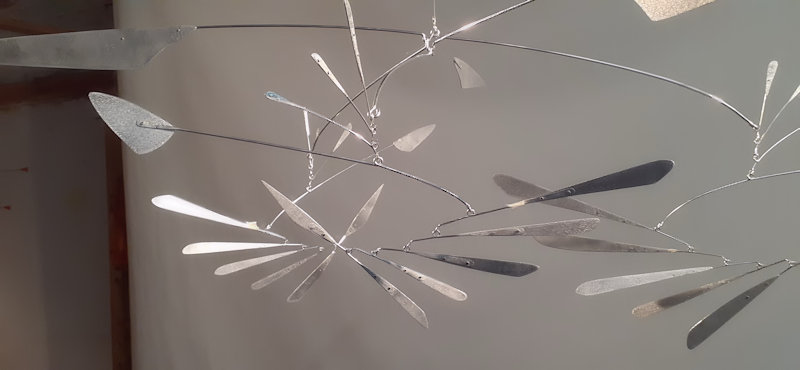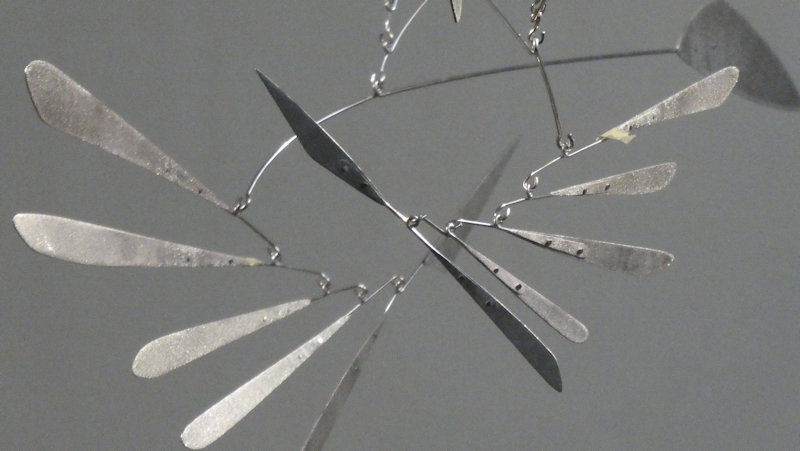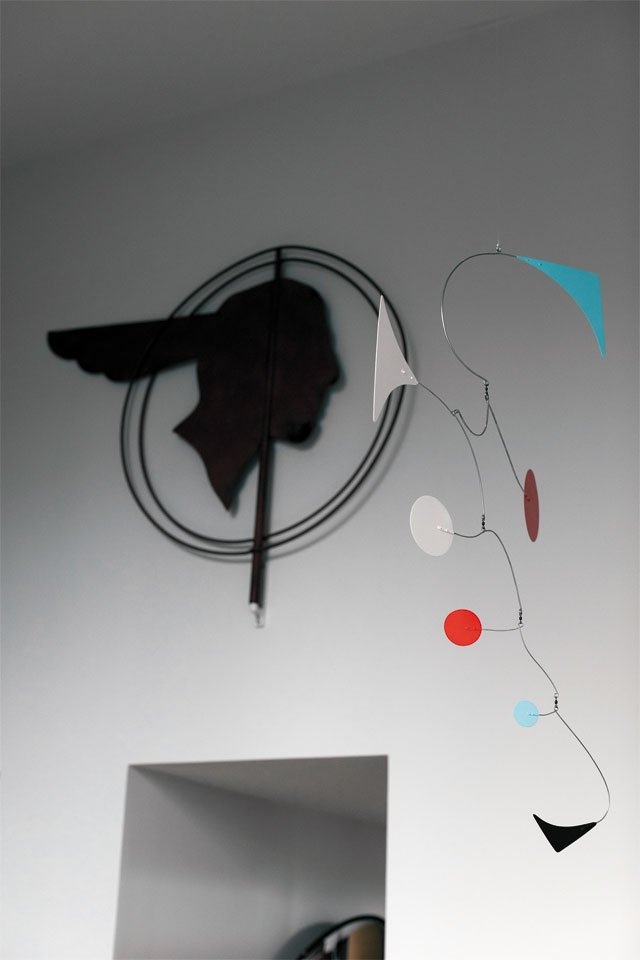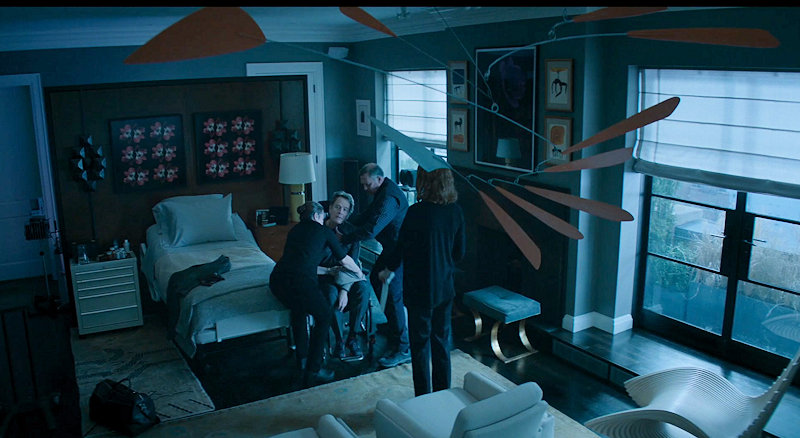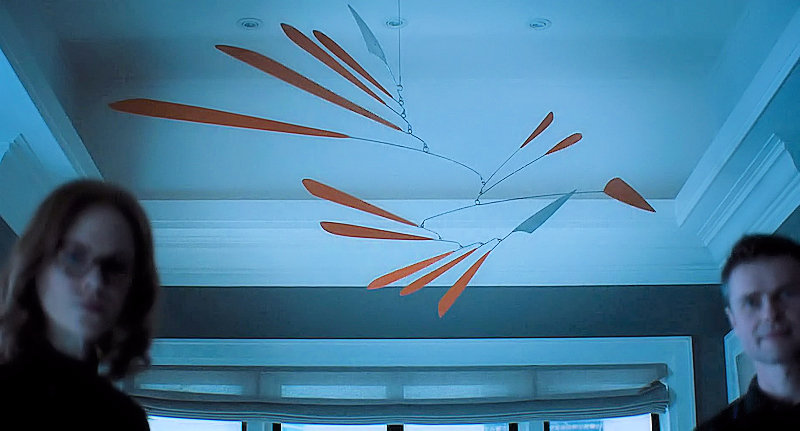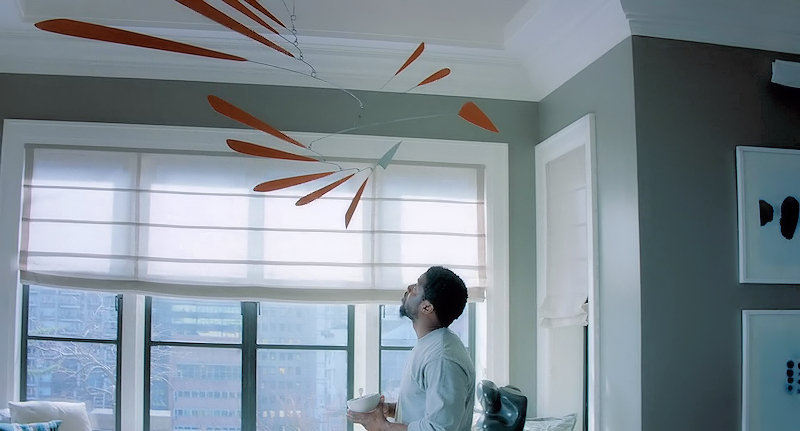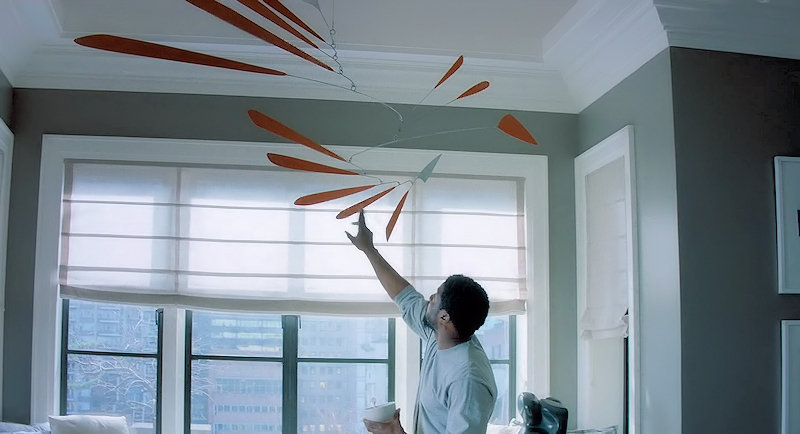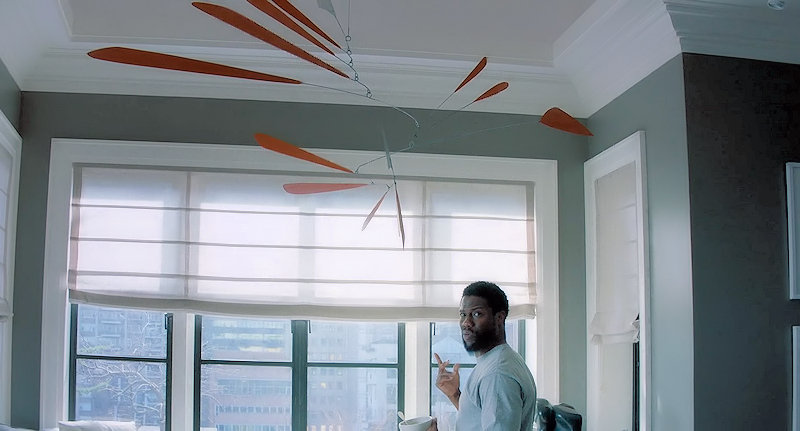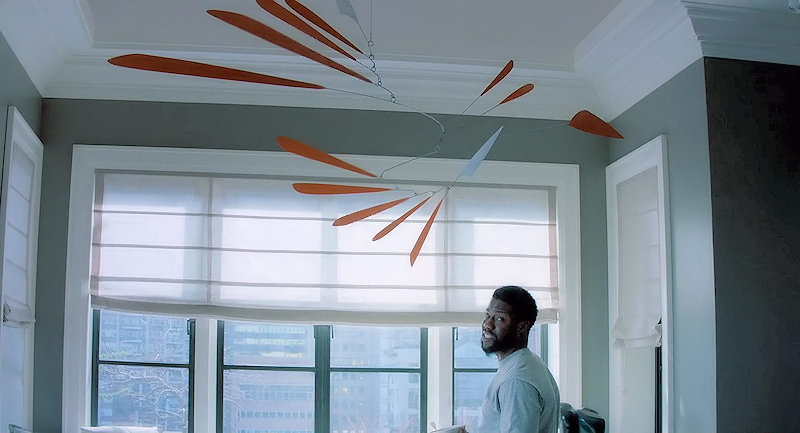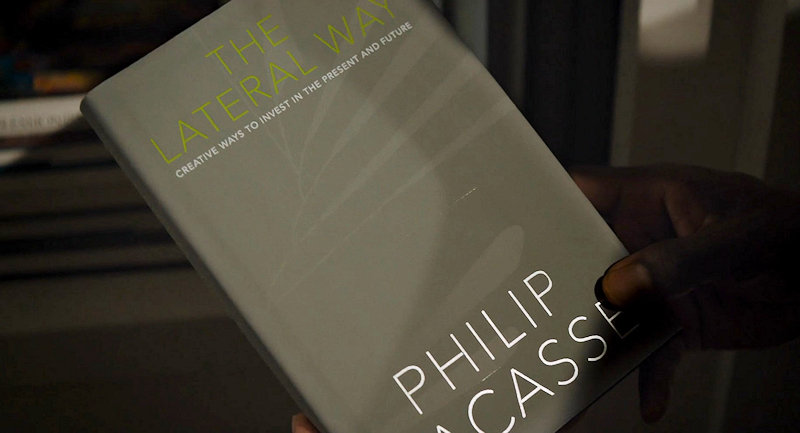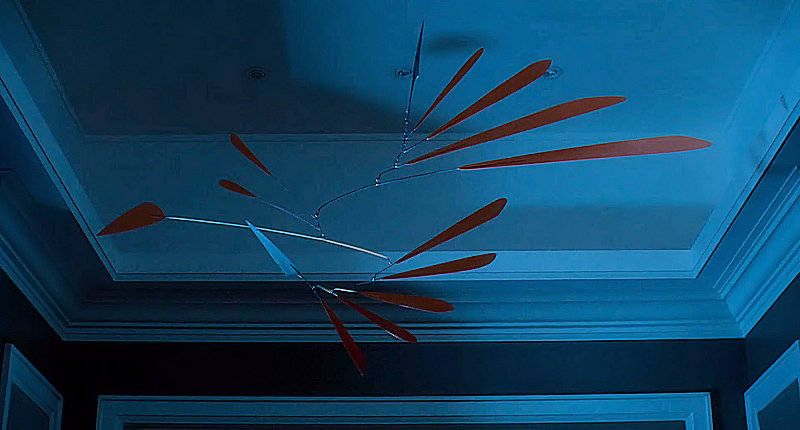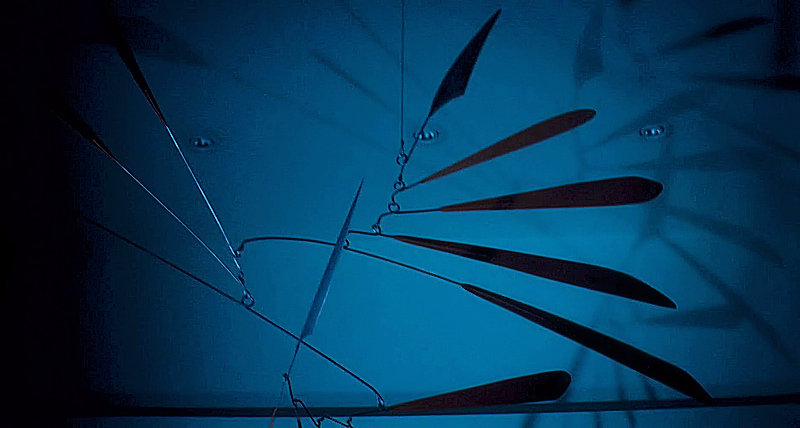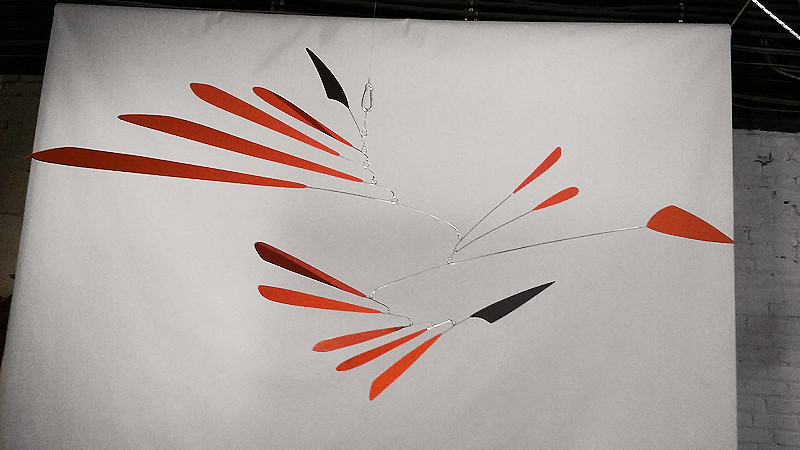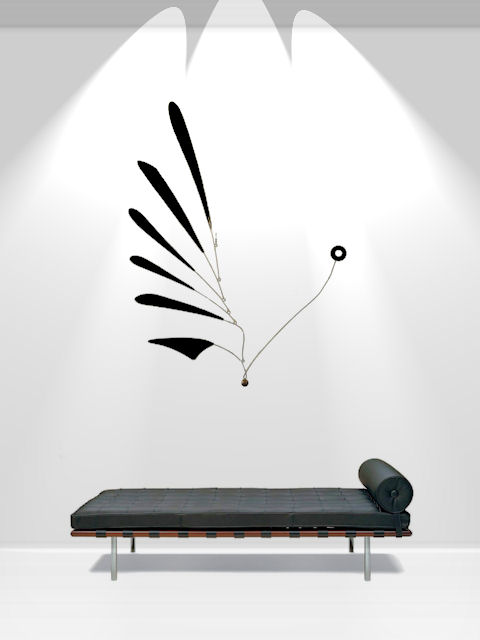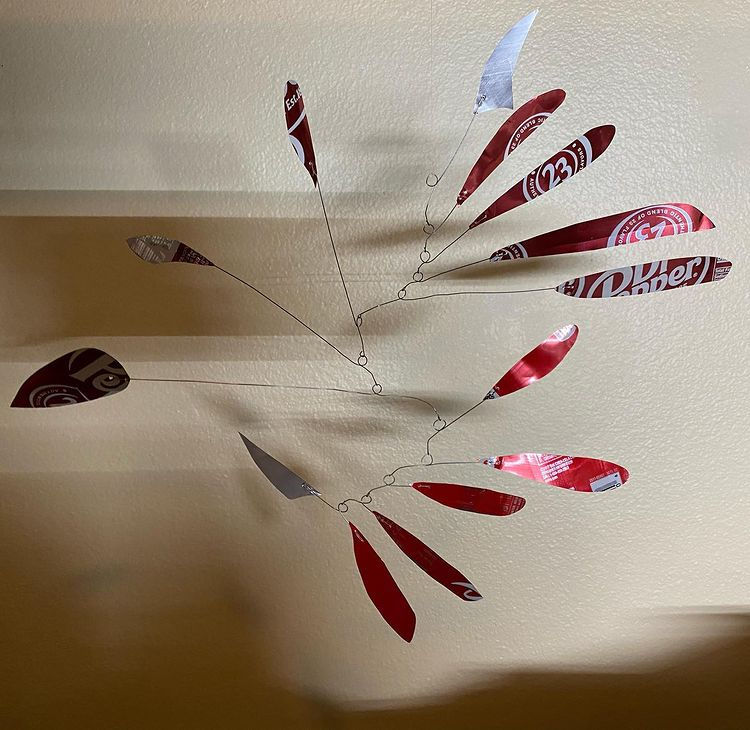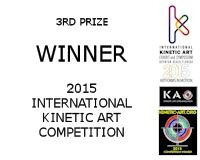Custom-Designed Mobile Sculpture for Atrium at Learning Commons at Kettering University
I’ve had the privilege to custom-design and make a two-part mobile sculpture for the atrium at the Learning Commons at Kettering University, a highly innovative state-of-the-art 105,000 square-foot architectural masterpiece designed by Travis Sage and the design team at Stantec, and in collaboration with President Robert K. McMahan and university staff.
The sculpture consists of two parts that visually correspond with each other and complete each other. Each part measures 25 feet (8 meters) in height and 16 feet (5 meters) in diameter. Made of aluminum to keep the sculpture lightweight and therefor susceptible to air movements within the space, the lower part weighs only 47 pounds (22 kg), the upper part only 39 pounds (18 kg).
The custom design of the two-part mobile sculpture, an application of a new approach to expanding Alexander Calder’s art form of mobiles:

Shown within the 4-story atrium:

View from the ground floor:

Render of the building:

The atrium:


Several weeks were spent on experimenting with fabrication techniques and inventing custom tools. Several jigs to facilitate the assembly process were also made. The balance point of each of the almost 50 parts had to be calculated precisely within the 3d model. The balance point of each part is dependent on the weight of the other parts. Each part had to be fabricated according to the 3d model, with some parts needing many adjustments until they positioned themselves correctly. In the process, the sculpture had to be raised and lowered hundreds of times, making additional adjustments to the parts each time.
The sculpture is made with a conventional hook-and-loop structure, as in a Calder mobile. A custom-made bending tool bolted to a table weighing 2 tons was utilized to allow for the metal rounds as thick as 3/4 inch (2 cm) to be bent into tight loops with an inner diameter of only 1 inch (2.5 cm):

Calculated measurement marks lining up perfectly after a loop was bent, ensuring that the balance point will be precisely in the correct place:

The 3d model of the atrium with the space utilized by the mobile (in red) to ensure that as the kinetic sculpture rotates and moves with the air currents, it will always remain out of reach from the various floors:

A video illustrating the various suspension options for mobile sculptures in the atrium:
Abstract metal shapes in the fabrication process:

The spreadsheet for one of the two sections, comparing the weight of the parts in the 3D-model to the actual weight of the parts as they were being made. The difference throughout the fabrication process had to be kept to a minimum to ensure that each part of the almost 50 parts, and the sculpture as a whole, would balance correctly. In the end, the weight difference between the model and reality was only 0.05% (0.31 ounces / 8.73 grams) of the total weight of the section:

Photo from installation day:
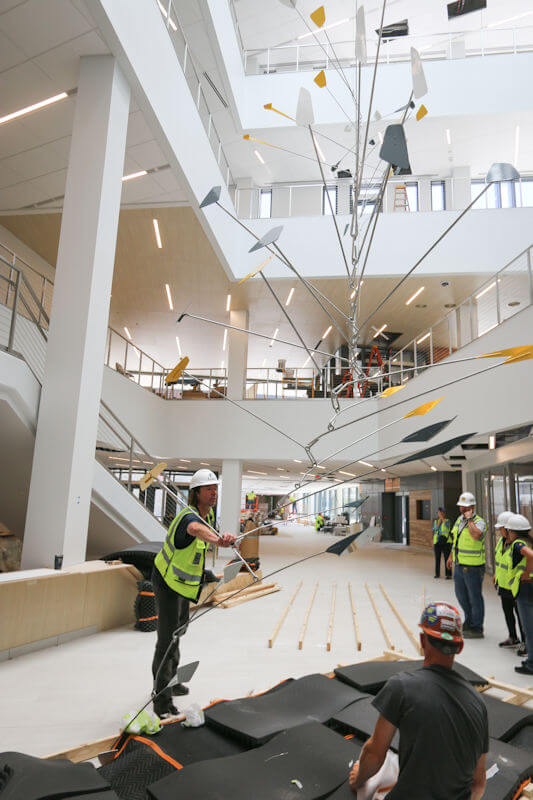
Photo from the opening ceremony in September 2022:
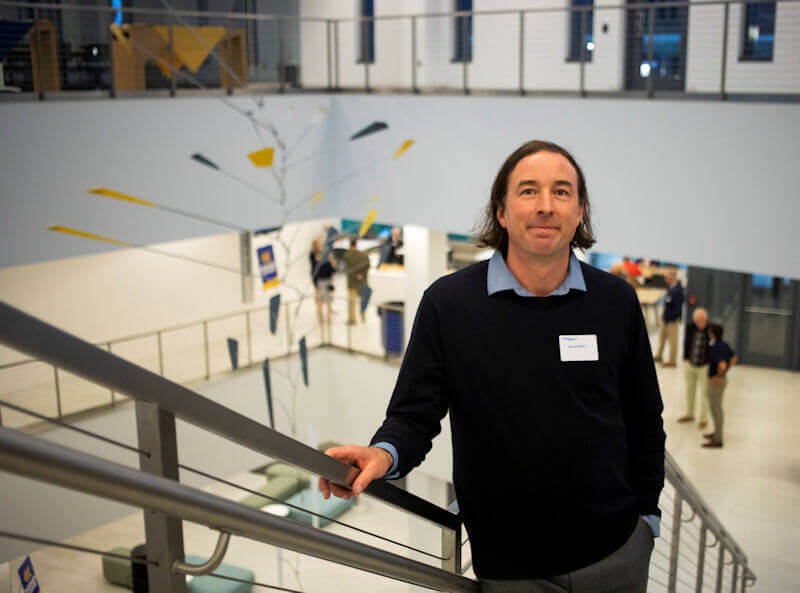
Thanks to Mike Rainer of Mike’s Machine & Welding for providing outstanding assistance with the fabrication of the mobile sculpture.
Update October 2023: The Learning Commons earns the Grand Prize at “Learning By Design” magazine’s Fall 2023 Architecture and Interior Design Awards of Excellence program.
I will be adding more images and information to this post as soon as I have time.
– See more of my art installations and mobile sculptures –
Custom-Designed Mobile for Private Residence in Key Biscayne
Photos of a large custom-designed mobile sculpture for a private residence in Key Biscayne, Florida. By the client’s request, via Venezuelan architect and interior designer Alejandro Barrios Carrero, the mobile is close in style to Alexander Calder‘s work.
A photo of the yet-to-be-painted mobile suspended in my work shop:
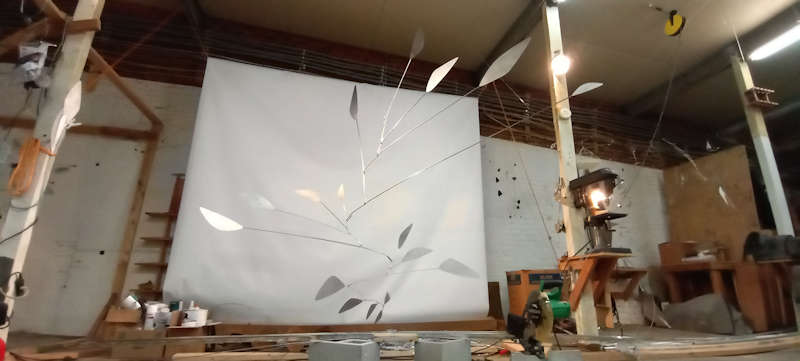
Photos of the mobile sculpture installed at the yet-to-be-finished residence (photos of the finished project will follow soon):
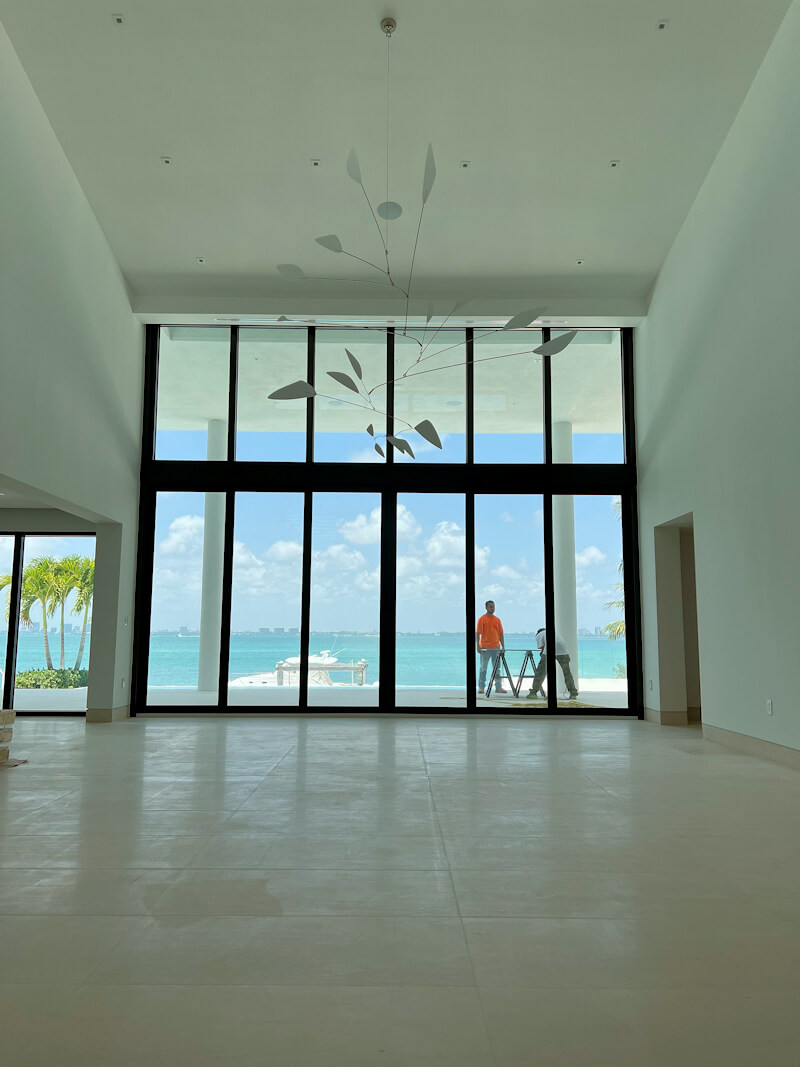
In the evening with shadows of the mobile sculpture on the walls and the ceiling:
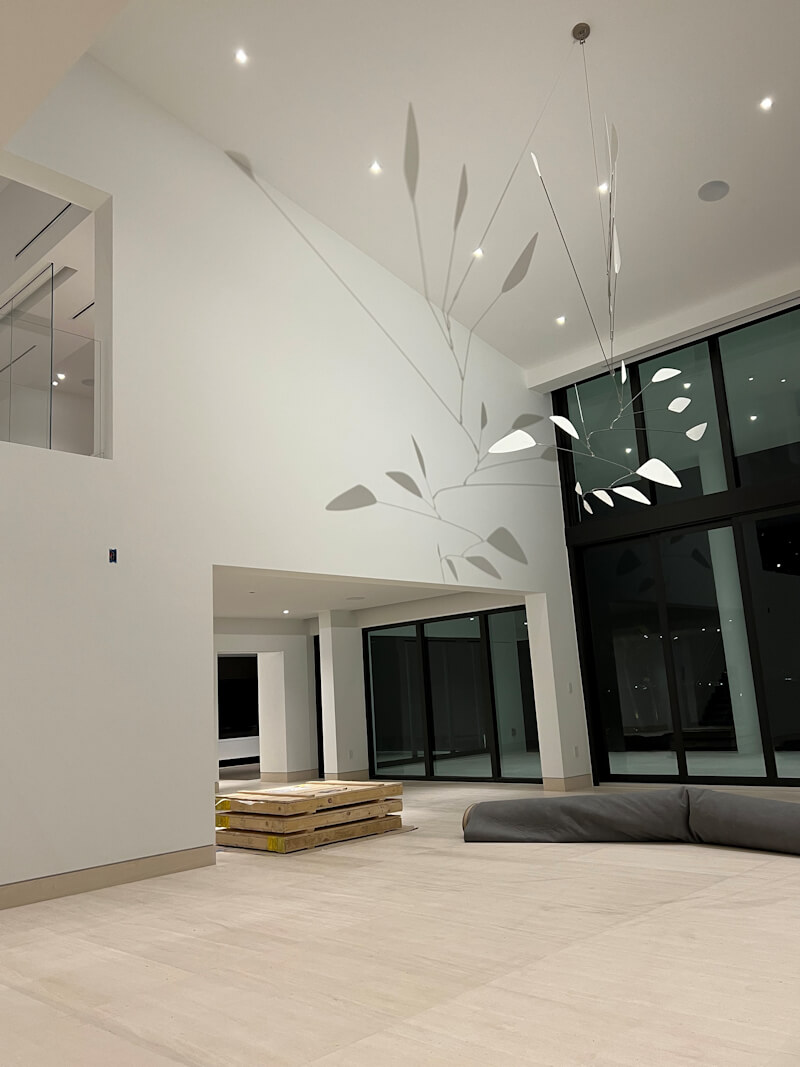
The sculpture is made of stainless steel and measures 136 inches (345 cm) in diameter and 107 inches (272 cm) in height.
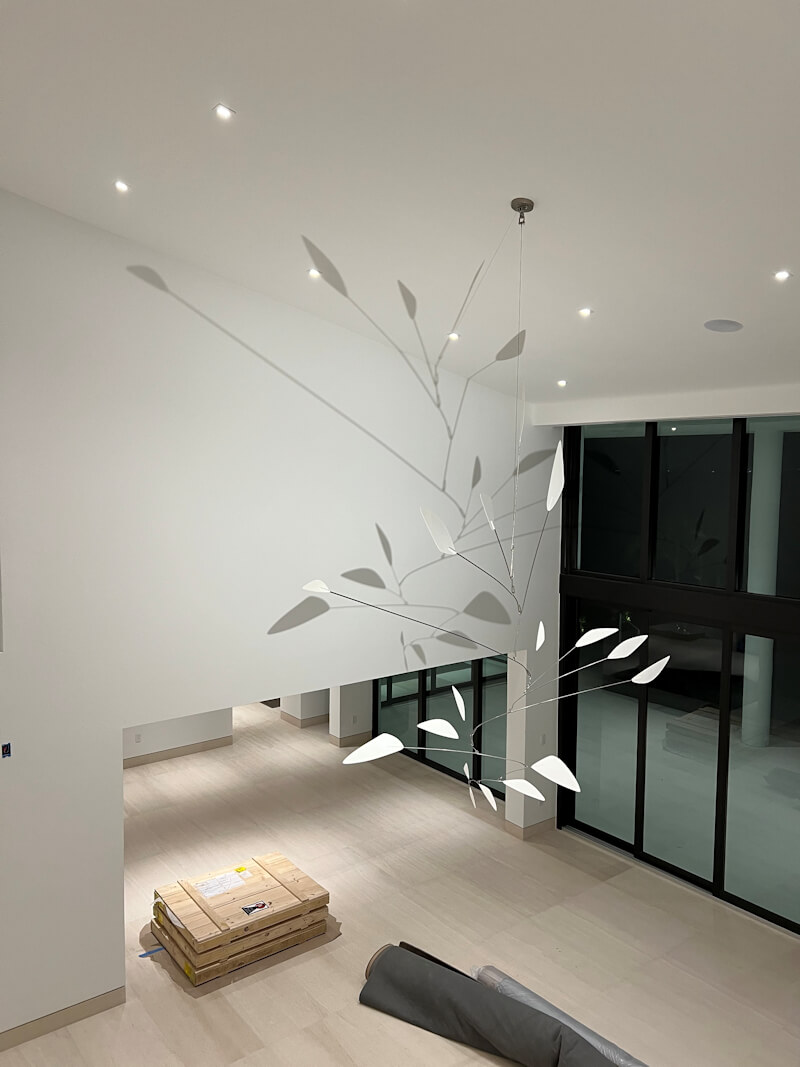
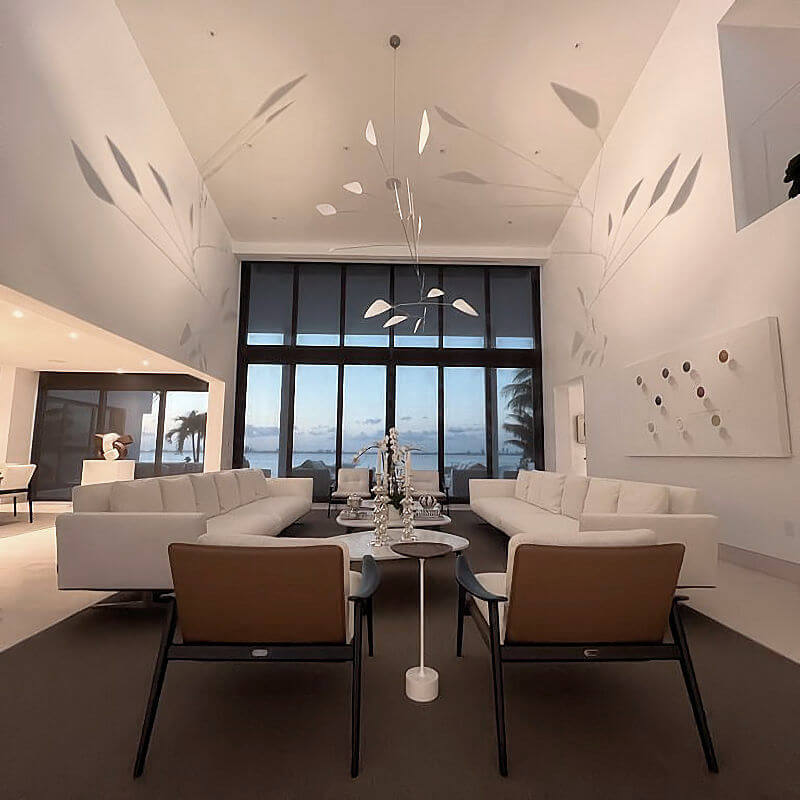
– See more of my mobile sculptures –
Contemporary Mobile Sculptures – Expanding Calder’s Art Form – Part 2
This is a continuation in progress (as of 2024) of my previous post Contemporary Mobile Sculptures – Expanding Calder’s Art Form with new mobile sculptures that I’m currently working on:
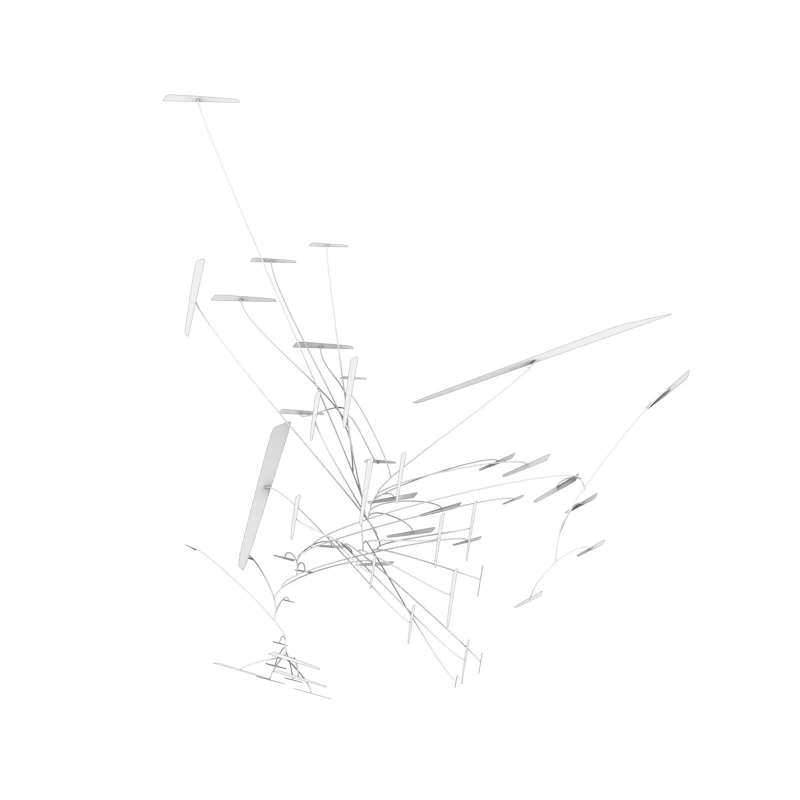
These are images of 3d models of the mobile sculptures that I’m working on expanding, with the balance point for each part precisely calculated. Each of these mobile sculptures has an interconnected balance structure throughout, just like an Alexander Calder mobile. The balance of each part is determent by the weight of the parts connected to it. This specific mobile sculpture, for example, is made of 51 balanced parts that are connected to each other, resulting in just one suspension point for the whole sculpture:
One of these mobile sculptures here shown with the precisely calculated balance points (103 points in total):
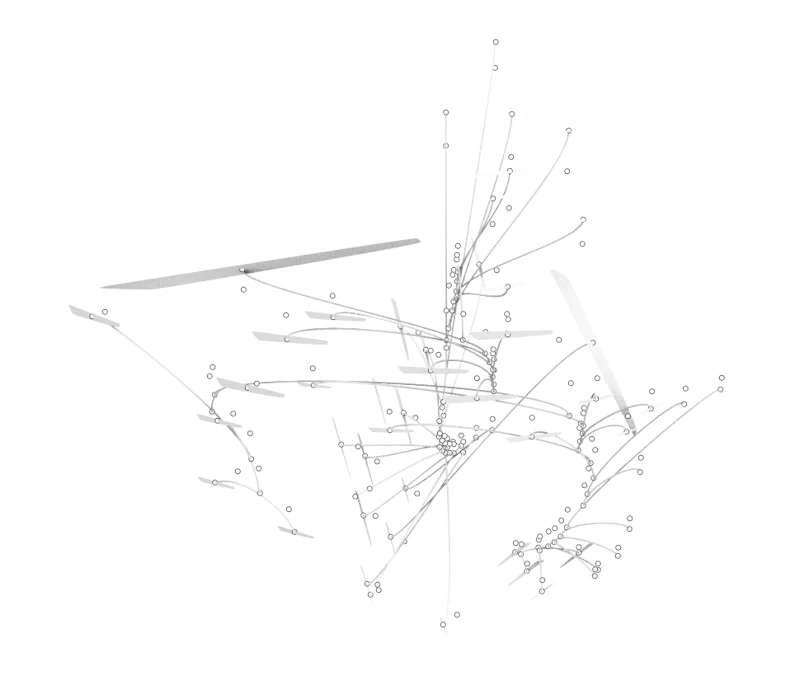
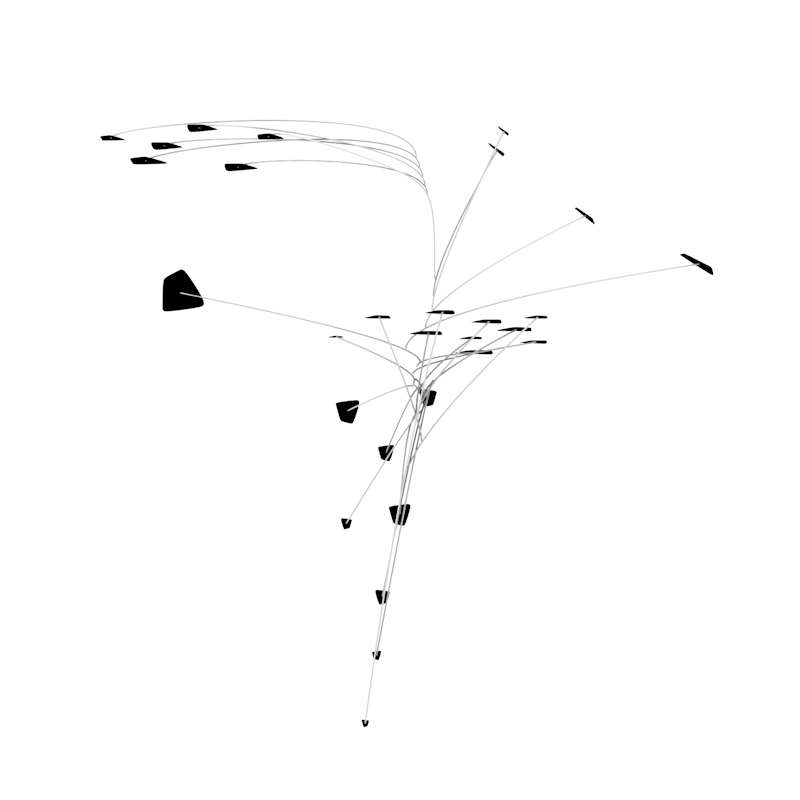
– See more of my mobile sculptures –
Contemporary Mobile Sculptures – Expanding Calder’s Art Form
What I’m currently (2024) working on in my apparently perpetual endeavor to expand the art form of mobiles beyond the limitations of Alexander Calder‘s work: Calder described his approach to designing and making his mobiles in a conversation with Selden Rodman in 1957: “I used to begin with fairly complete drawings, but now I start by cutting out a lot of shapes. Next, I file them and smooth them off. Some I keep because they’re pleasing or dynamic. Some are bits I just happen to find. Then I arrange them, like papier collé, on a table, and “paint” them – that is, arrange them, with wires between the pieces if it’s to be a mobile, for the overall pattern.” His mobiles become three-dimensional when suspended as each part moves and rotates with the air currents. But his approach to the layout of a mobile is essentially two-dimensional, on a table. Calder’s Vertical Foliage is good example to illustrate this. However, there seems to be creative approaches to fully three-dimensionally designed mobiles that Calder only very rarely ventured into (his mobile Red Cascade made in 1960 is an example). Here are some of the ideas and experiments that I’m currently working on and experimenting with, finding ways to expand his approach (and there’s also a continuation of this post Contemporary Mobile Sculptures – Expanding Calder’s Art Form – Part 2):

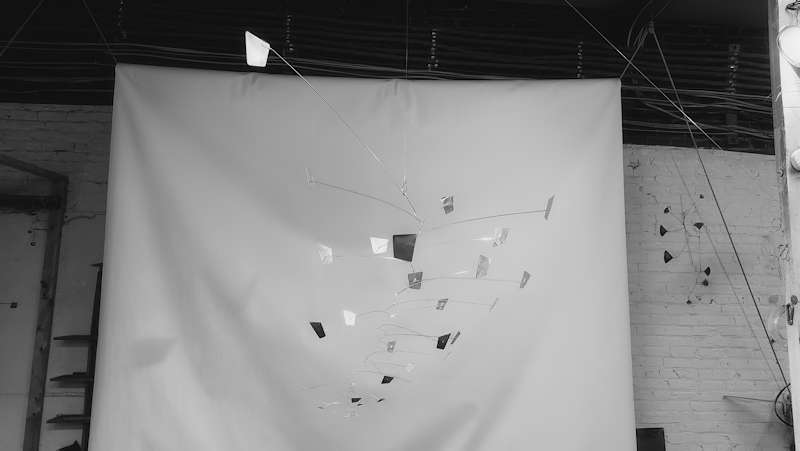

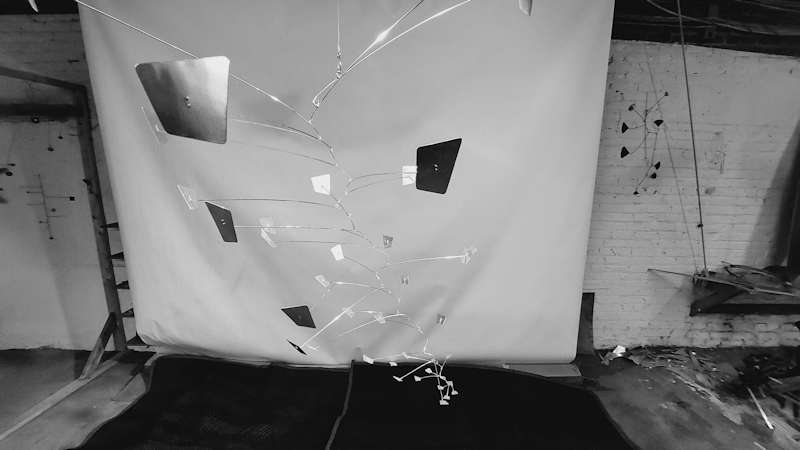
George Rickey, while outlining the early explorations by artists into kinetic art from 1912 to 1932 in his book Constructivism – Origins and Evolution (published in 1967, and to my knowledge, the most wide-ranging and comprehensive book on the subject of Constructivism to date), remarked: “It was Calder who succeeded in securing a place for kinetic art. He started making mobiles twelve years after Gabo’s Manifesto, and his first exhibition of these was in 1932 at the Galérie Maeght in Paris. Although his mobiles have since become famous and popular and have enlarged the limits of art, his style, deriving from painterly concepts, has had little influence on the new generation, especially the more mechanically inclined. Until his stabiles of the last decade, Calder retained a two-dimensional outlook in sculpture devised as outline drawings, often witty, with ingratiating movement added. He seemed indifferent to the wide possibilities of a kinetic art. He discovered a new world but did not explore it.“

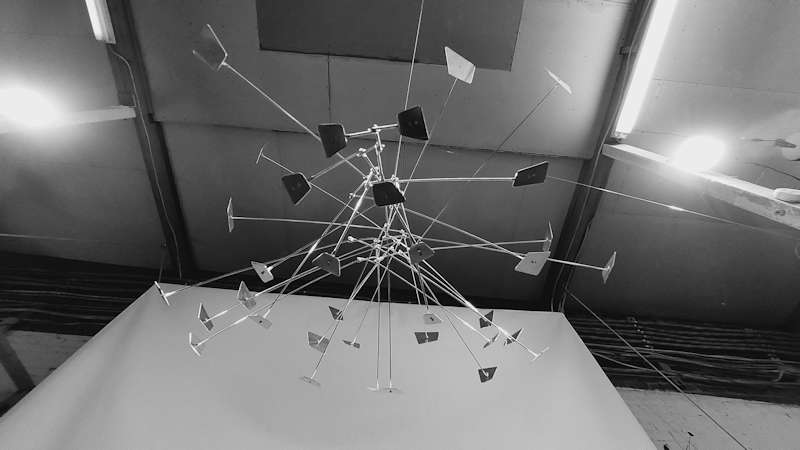

To put the idea in different words: Calder’s process began with seeing Piet Mondrian‘s paintings and feeling the impulse to make the static abstract shapes in the paintings move. He translated this idea to his mobiles quite precisely, essentially creating two-dimensional abstract paintings made of a series of flat shapes that move. Most of them only happen to become three-dimensional because these two-dimensional abstract “paintings” (essentially two-dimensional planes made of a series of flat shapes) happen to curve three-dimensionally when moved by air currents. He remained devoted to this approach with his mobiles and veered from it only very rarely, and not far when he did.
In 1962, in a review in Arts Magazine of an exhibit of Calder’s work at Tate [PDF], George Rickey wrote: “The mobile, even if flexible, is two-dimensional, like a drawing on a rubber sheet. The sinuous tracery of each set of wires profiles may sit contrapuntally against the next, but flat against flat. With the parts swinging around a vertical axis, the galaxy occupies space but does not energize it. Calder has run through the permutations of these wire profiles; yet, apart from some perfecting of wire technology, extension and refinement of his vocabulary of shapes (the Arpesque flame forms are the best), and increased size, he shows very little advance in the expressive use of movement in the thirty years since Calderberry Bush [also known as Object with Red Discs, made in 1932 and regarded as Calder’s first mobile sculpture]. It is not the first time that an artist has been confined by his own invention; it happened to Samuel F. B. Morse. The Master of the Catenaries has become the prisoner of the chain he forged.“
To expand Calder’s idea, one could create mobiles with the same balance structure as Calder’s mobiles (based on the whippletree mechanism), and create moving abstract “paintings” that are truly three-dimensional, not just two-dimensional planes made of a series of flat shapes that curve with the air currents.

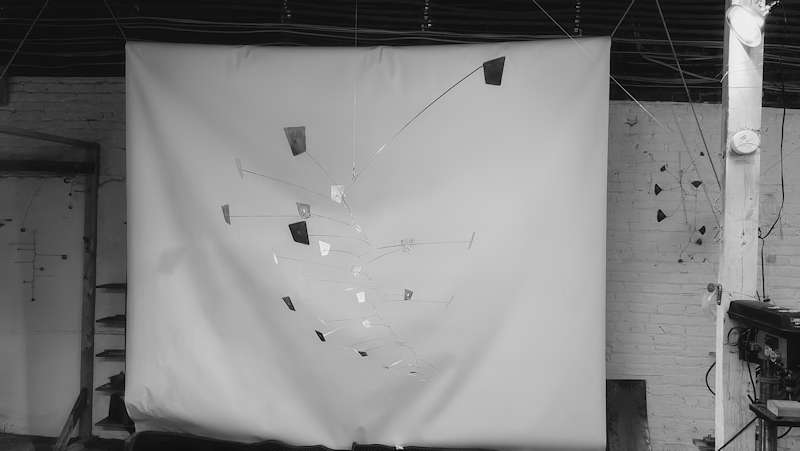
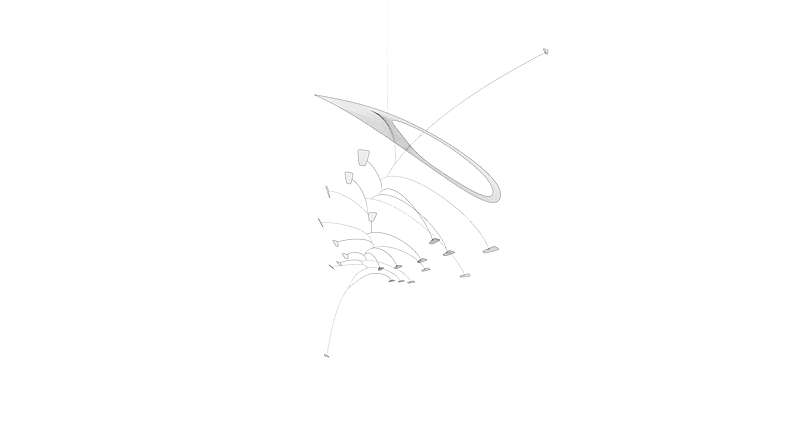
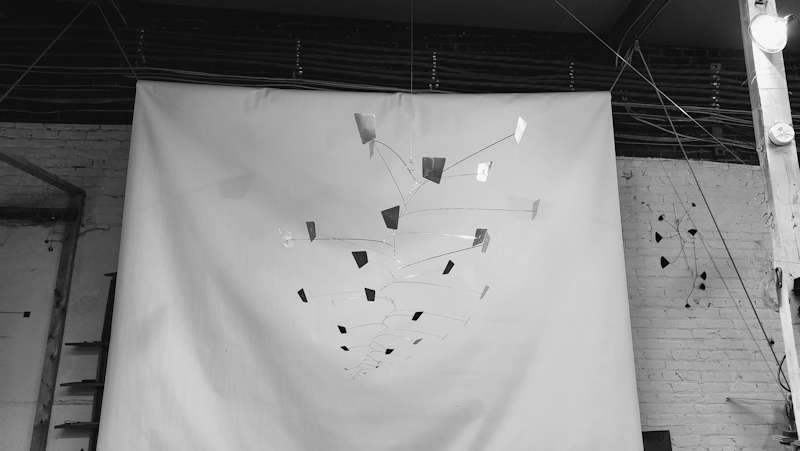
In his later years, Calder designed and made some of his mobiles consisting of two (or more) horizontal and vertical planes, each one being essentially arranged in two dimensions. His hanging mobile titled Lone Red Among Blacks (1961) is a good example to illustrate this. Here again, the three-dimensionality was a result of combining two or more “flat” two-dimensional arrangements, not of a fully three-dimensional arrangement.
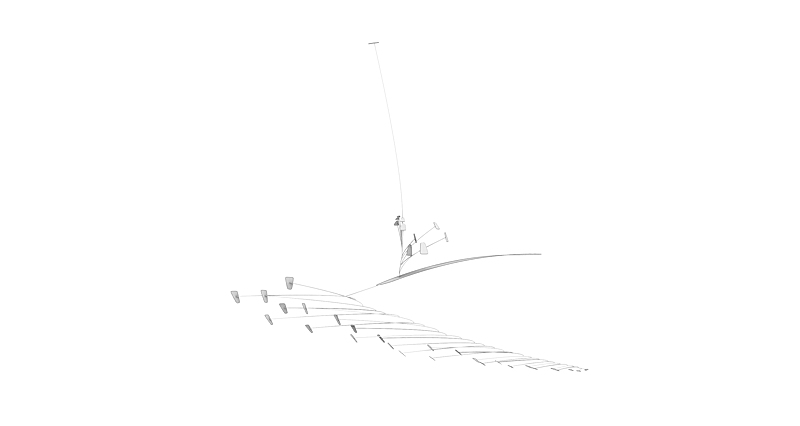
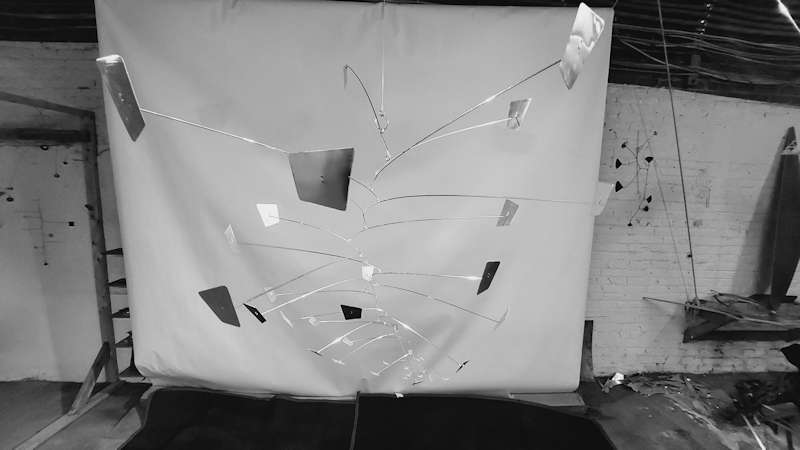
These mobiles shown here are still designed with the interconnected balance structure where the balance of each part depends on the other parts, as in a Calder mobile. And same as in Calder’s mobiles, it’s essentially an upside down whippletree mechanism, which probably dates back to between 190 to 209 AD, and has been used to distribute force evenly through linkages when horses or mules pull a plow or a wagon:
Man Ray was the first artist (to my knowledge) to utilize this balance structure in a suspended sculpture with his piece titled Obstruction in 1920 (if you’d like to read more about the history of mobiles, please see my page Mobiles before Calder – Who Invented Mobiles – A History of Mobiles Part 1).
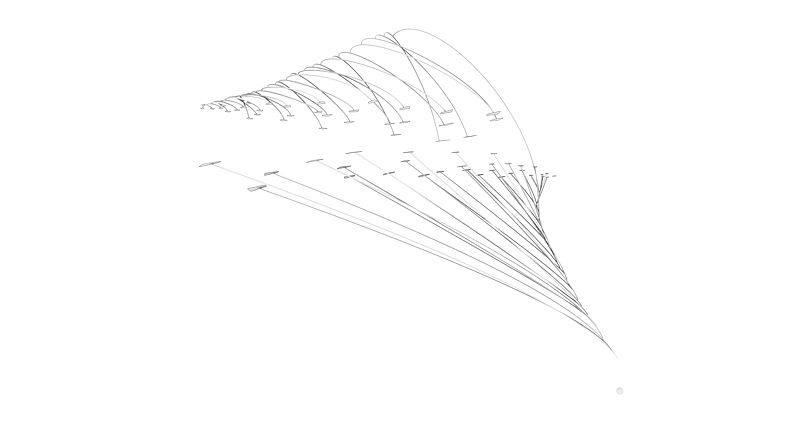
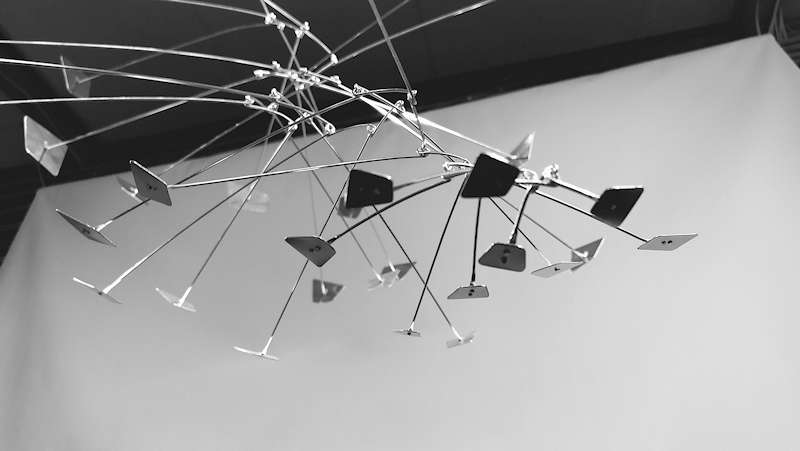

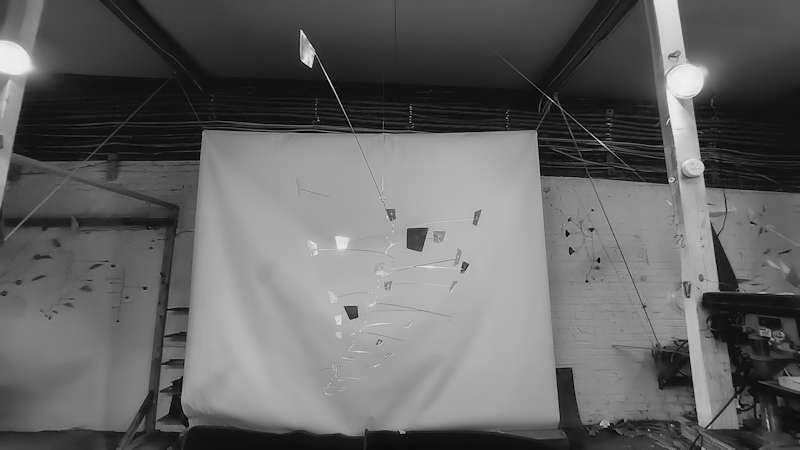
Almost all artists who have made mobiles since Calder have adapted his two-dimensional approach. Few have worked to move beyond and explore the possibilities of fully three-dimensionally designed mobiles that utilize the interconnected balance structure that distinguishes them from simply suspended sculptures (please see my page Mobile Sculpture Artists – A History of Mobiles – Part 2 for some examples). George Rickey recognized the limitations of Calder’s two-dimensional approach to mobiles and expanded the art form, although many of his pieces don’t utilize an interconnected balance structure throughout. After around 1950, he often also opted for standing sculptures instead of suspended ones. Lynn Chadwick, Tim Prentice, Jerome Kirk, Derick Pobell, Laurent Martin “Lo”, Philippe Jestin and Jade Oakley have found ways to some extend to free the art form of mobiles from Calder’s two-dimensional approach. Tim Prentice expressed the challenge in a conversation with Nicholas Fox Weber (published by Maxwell Davidson Gallery in 2000): “Calder was credited with inventing sculpture with moving parts, so for me Rickey was incredibly important because he demonstrated that this concept wasn’t any one man’s property. I can do it to a limited degree. I can draw a line and have it curve, undulate, curl, turn, twist – in that sense, the line is changing – and I can do it with planes. The next challenge would be to do it with volume.” Volume as in three-dimensional planes instead of two-dimensional planes? Or no planes at all?

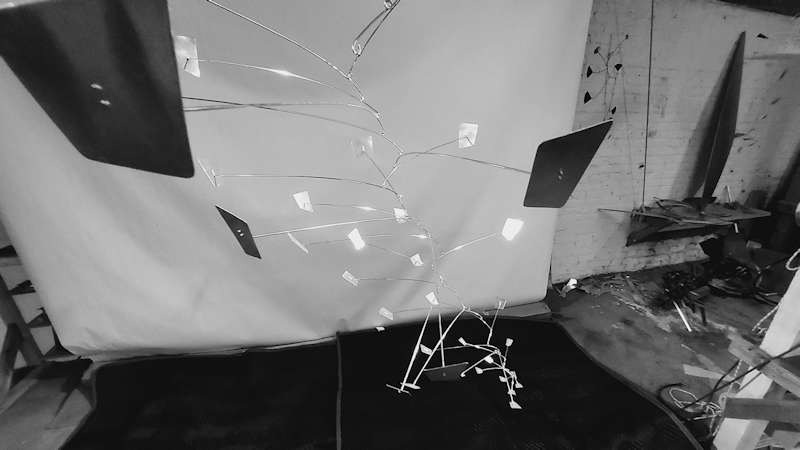
On the topic of Calder and Rickey, Tim Prentice wrote in his book Drawing on the Air – The Kinetic Sculptures of Tim Prentice: “If you compare the two, Calder was a great storyteller [and an entertainer] and not a theorist. When anyone asked him tough questions about his work, he hid behind his humor. For example, when asked how he knew a piece was finished, he famously answered, “When it’s dinner time.” He operated entirely on intuition. By contrast, Rickey was an intellectual and teacher. He was far more strict in his use of Constructivist principles. He analytically isolated movement in the way Josef Albers isolated color. [Rickey] and Calder represent the two contrasting sides of the brain.” Tim Prentice’s work greatly expands the art form of mobiles. He seems to build on Rickey’s approach more than on Calder’s. As he himself has explained: “As I concentrated on reducing weight and friction, the decisions came to be based more on engineering and less on aesthetics” and “we make the machine and keep our artistic instincts out of it and the air comes along and does the art.” Can the contrasting approaches be combined in new ways?
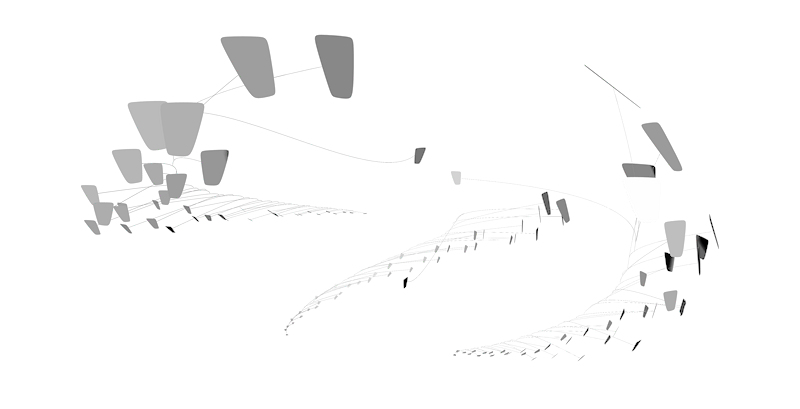
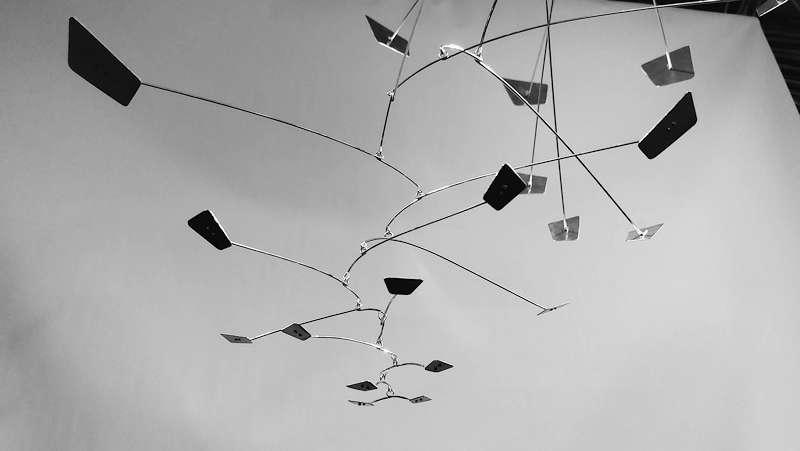
Building on Calder’s hanging mobile 13 Spines (1940):
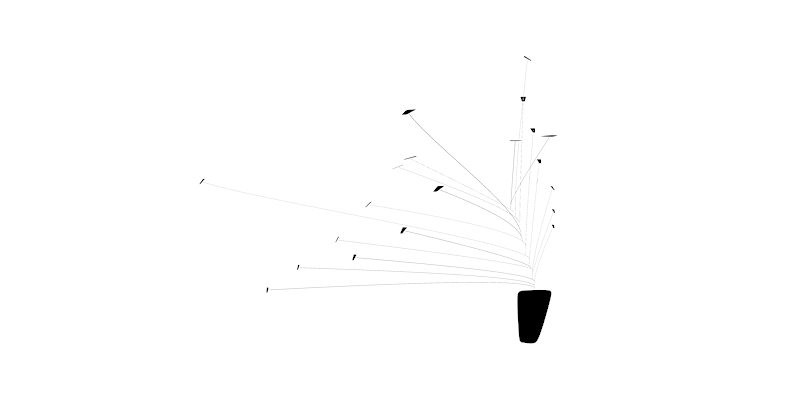
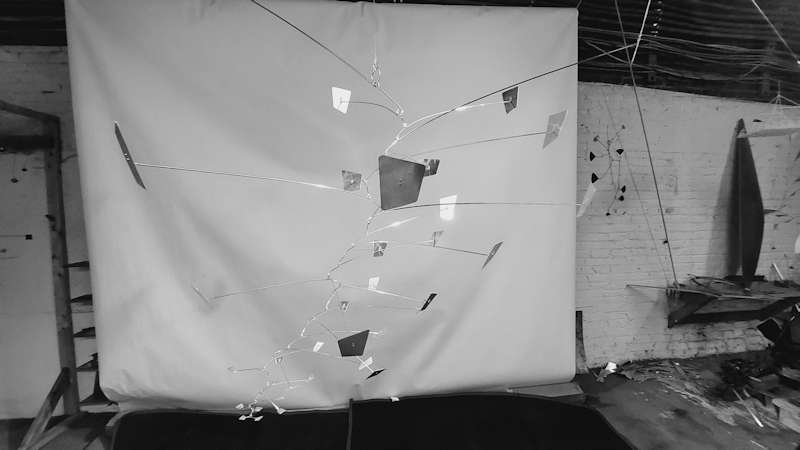
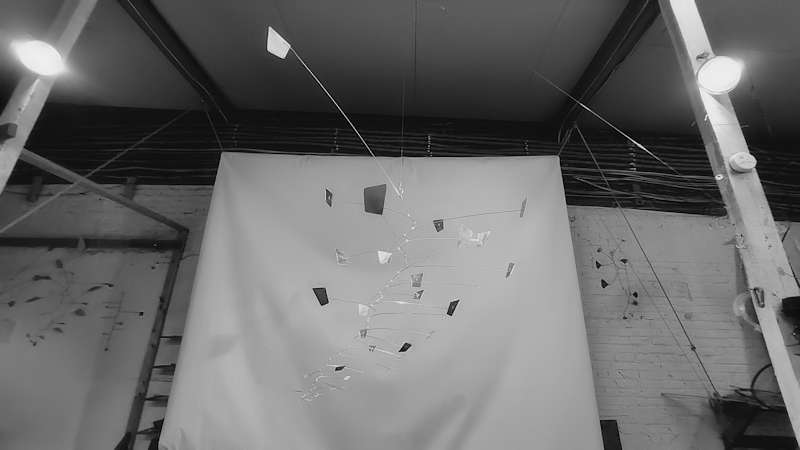
Photos reverse the idea of turning an abstract painting or drawing into a three-dimensional moving sculpture. They turn it back into a flat immobile image made of abstract shapes. Two-dimensional layouts in mobiles, like many of Calder’s mobiles and the more conventional mobile sculptures I made some years ago, are easier to capture and comprehend in photos. While video can provide a solution to this, most people discover new art in the form of photos nowadays, especially now in the digital age. You can make an amazing three-dimensional sculpture, but if the sculpture doesn’t allow you to represent its idea comprehensively in images and photos, then you’re limiting the reach of the idea greatly. As Sarah Sze put it in an interview with Melissa Chiu: “In many ways, great artworks are known primarily through photos – so arguably the photos are as important as the artworks themselves.”
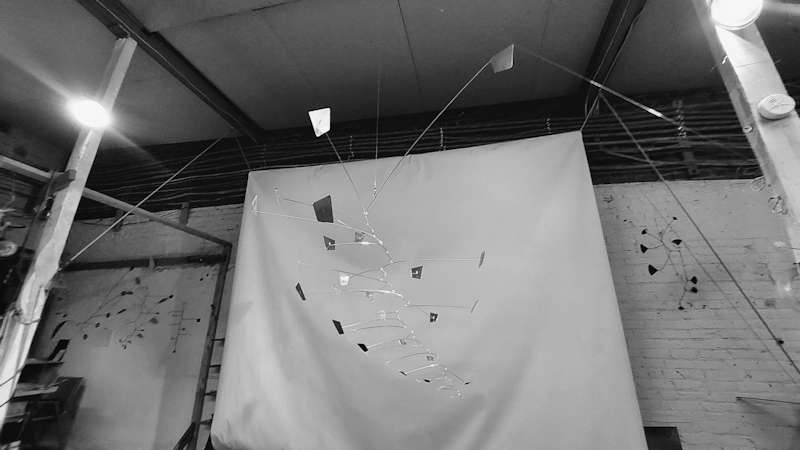
An approach that seems architectural to me:
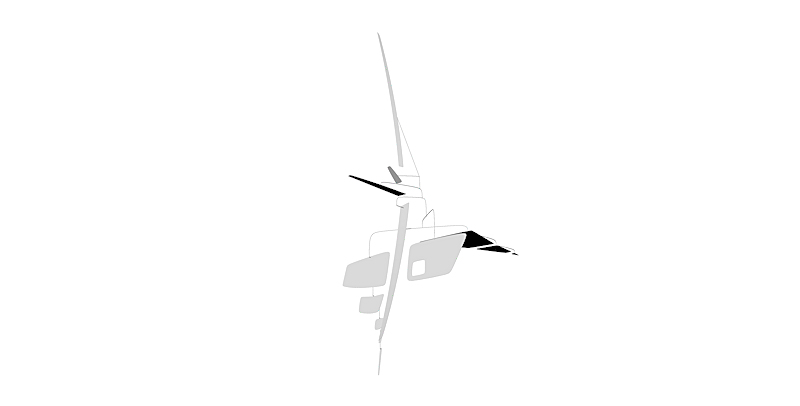
The balance structure of a mobile (the whippletree mechanism) is like a few simple chords on an instrument: simple, but the possibilities of what can be done with it are infinite.
“Paintings are but research and experiment. I never do a painting as a work of art. All of them are researches.” – Pablo Picasso, in an interview with Alexander Liberman for Vogue in 1956.
Or as architect Santiago Calatrava has pointed out: the surrealist André Breton said, “Everyone knows what a head looks like”, to which Alberto Giacometti retorted: “Not me.”
See the continuation of this post Contemporary Mobile Sculptures – Expanding Calder’s Art Form – Part 2 with additional new mobile sculptures that I’m working on based on this approach.
As with anything on my website, if you have any suggestions, anything that should be added, corrected, or have any questions or comments, please let me know.
– See more of my mobiles –
Photos of Me at My Shop – Mobile Sculpture Artist
Photos by Swiss-Australian filmmaker, video artist, and photographer Tanya Stadelmann of me working at my shop:
Original 3 Part Mobile Sculpture
Photos of a custom made mobile, yet to be painted, and based on an additional design idea from a mobile sculpture made for the movie The Upside, which in turn was based on my Mobile 92.
Made out of aluminum and stainless steel and with a diameter of 60 inches / 150 cm, it weighs less than a pound / less than half a kilogram, and therefor moves with the slightest air currents.
Unlike a conventional mobile by Alexander Calder, this is essentially one mobile made of three mobiles. I believe this is quite unique and original, I’ve not seen a mobile like it.
A “fly around” animation of the design:
Painted:
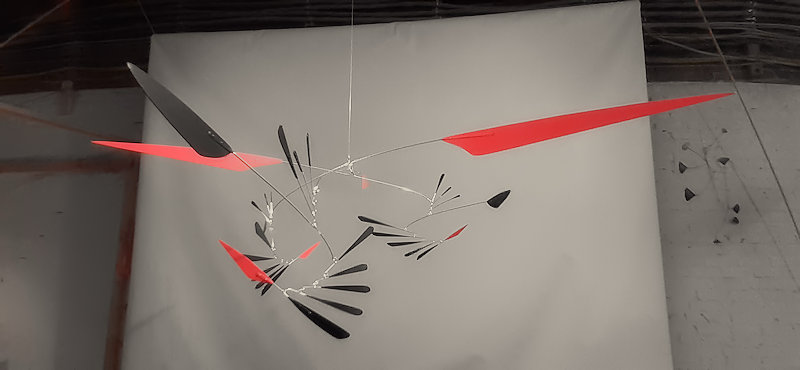
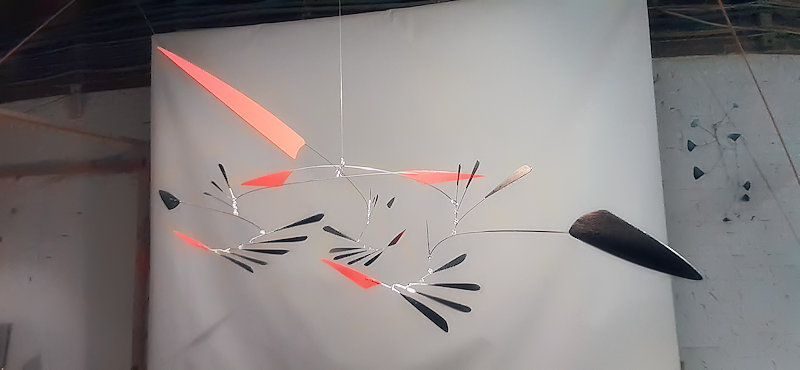
Custom made wooden box for shipping:

– See more of my custom made kinetic sculptures and suspended mobiles –
Marco Mahler gives new life to the kinetic art form Calder made famous – RHome Magazine
New Article in R•Home:
Marco Mahler gives new life to the kinetic art form Calder made famous
It talks about how I got inspired by Alexander Calder’s mobiles at the National Gallery of Art’s Tower 2 in Washington, D.C. to make my first mobiles, then made small mobiles and kinetic sculptures that I sold on online, got commissioned for a series of mobiles for a New York Fashion Week, winning third prize in the 2015 International Kinetic Art Organization competition, a custom mobile for Robert A. M. Stern, New York architect and dean of architecture at Yale, collaborated with mathematician Henry Segerman to create 3D printed mobiles, a custom designed mobile sculpture that I made for the 2019 movie The Upside starring Bryan Cranston and Nicole Kidman, and some of my new ideas for suspended kinetic sculptures for future projects.
Mobiles shown in the article are Mobile 92 and one of my original contemporary mobile sculptures. Some of the 3d printed mobiles and a shape for a large custom mobile are visible in the background, as well as some of my other contemporary mobiles.
Thanks to Elizabeth Cogar and R•Home managing editor Susan Morgan!
Incidentally, a mobile that I custom-made for architect and former Dean of the Yale School of Architecture Robert A.M. Stern for his room at The Kips Bay Designer Show House is featured in the following issue of R•Home Magazine in the feature article about interior designer Doug Stiles and his condo in Richmond’s Bellevue Square where the mobile is currently suspended:
Outdoor Standing Mobile Sculpture for Bahamian Residence
Images of an outdoor standing kinetic mobile sculpture I custom designed and custom made for a private residence in the Bahamas this past winter.
The design:
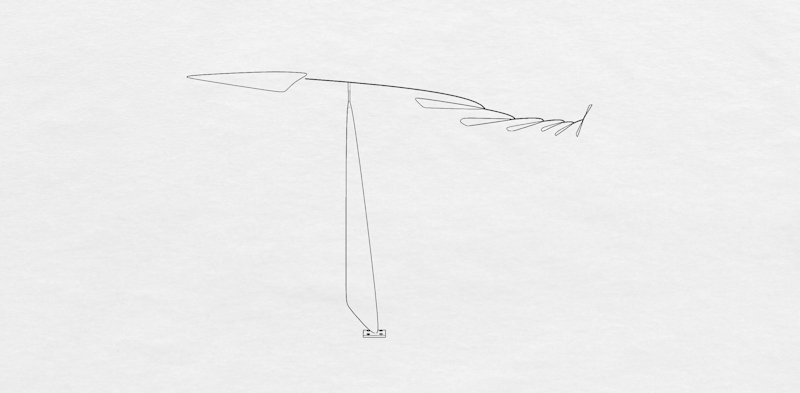
The residence:
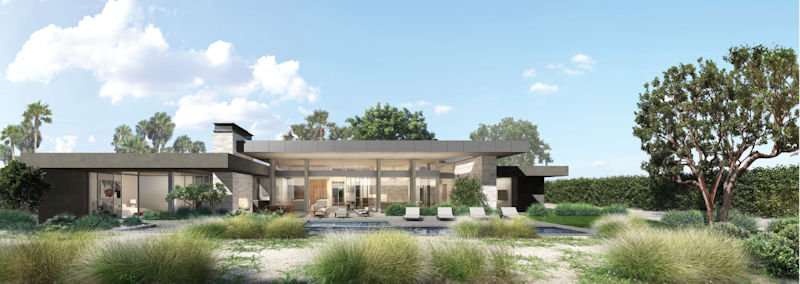
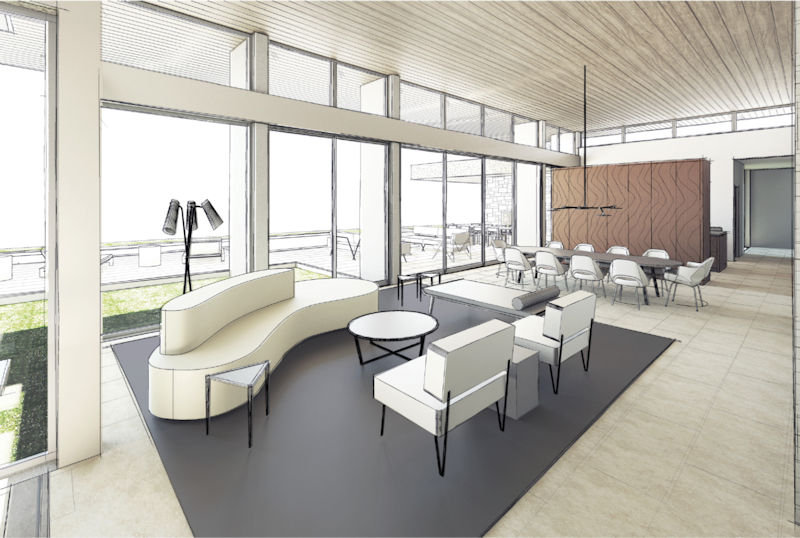
The finished sculpture:
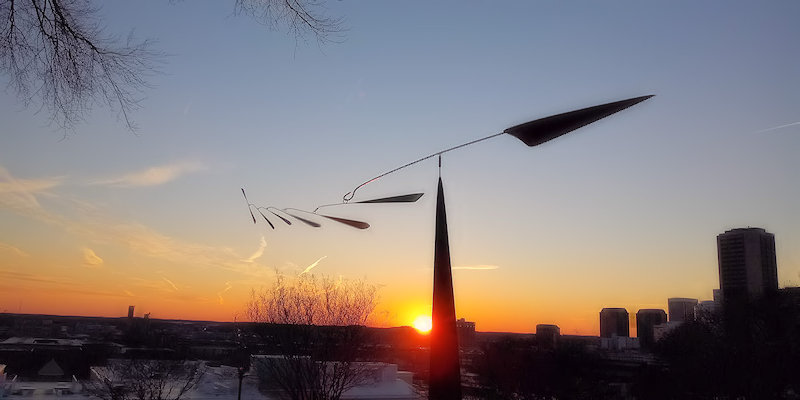
Indoor storage solution for stormy days:
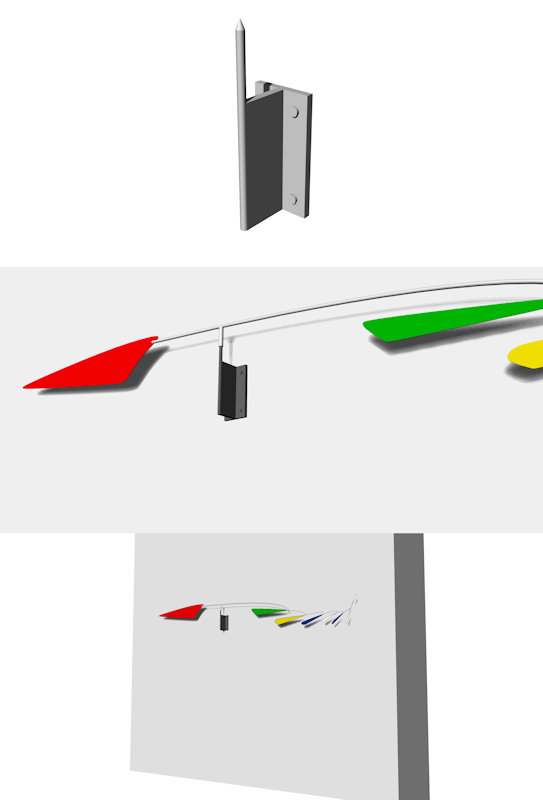
Ready for shipping:
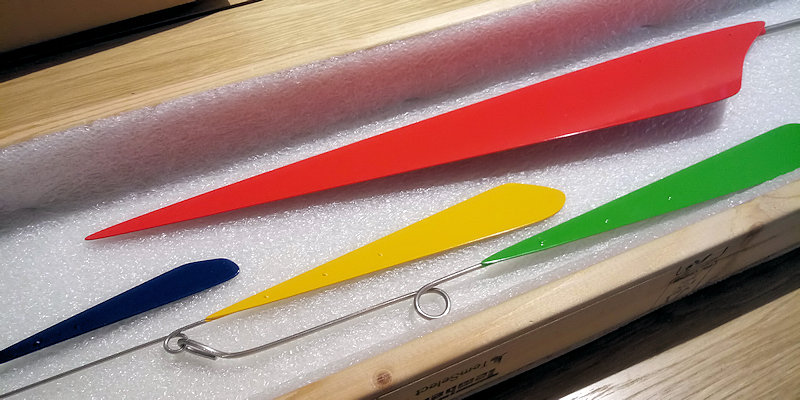
Installed on site:
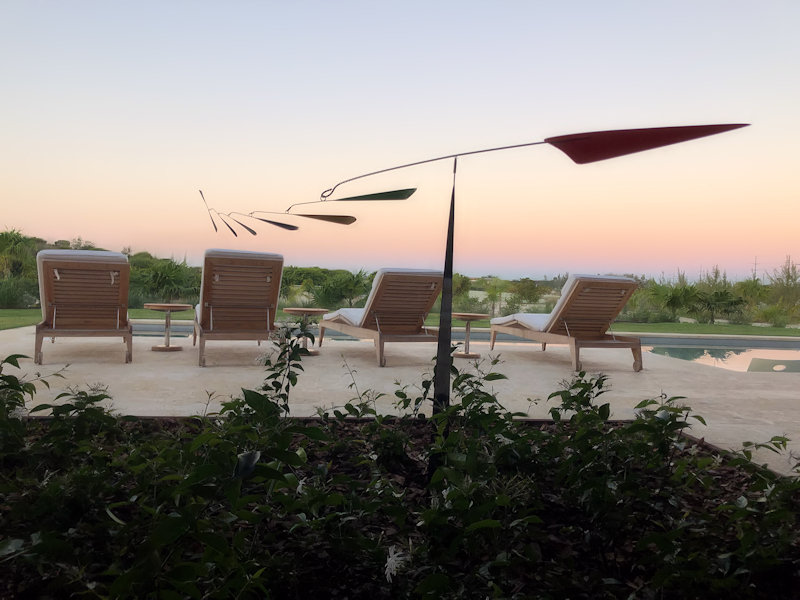
A painting by David Hockney complementing in dynamics and colors hangs on the wall in the background:
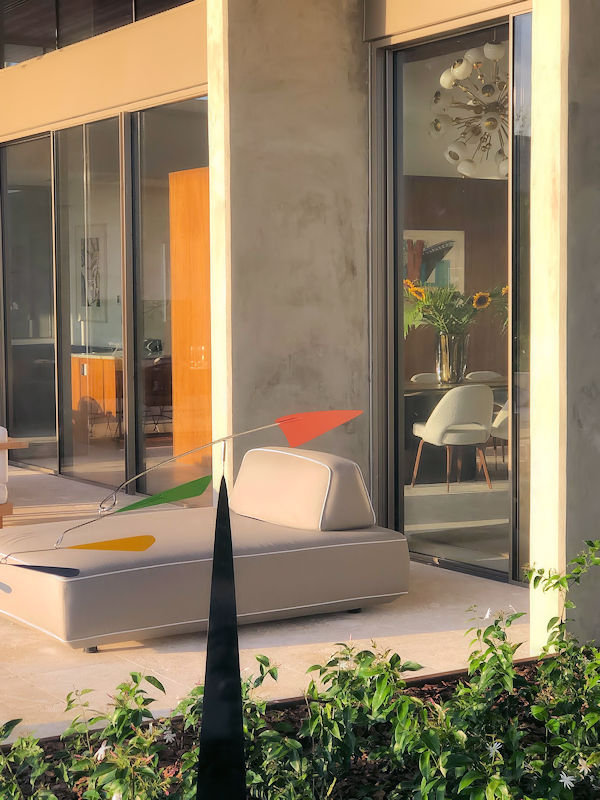
– See more of my custom made moving sculptures –
Custom Kinetic Mobile Sculpture for the movie The Upside
In 2017, I made a custom designed mobile for the movie The Upside, featuring Bryan Cranston, Nicole Kidman and Kevin Hart. The trailer for the movie in which the mobile is featured several times was released on October 3rd 2018, and the movie itself was released on January 11, 2019. It reached a total worldwide gross of $122.7 million. The film follows a paralyzed billionaire (Bryan Cranston) who strikes up an unlikely friendship with a recently paroled convict (Kevin Hart) whom he hires to take care of him. Although not clearly implied in the movie but discussed during the design process, the mobile was a present from Bryan Cranston’s character’s wife who passed away from cancer, and in the movie symbolizes their past love and marriage, as well as his character’s past passion for paragliding.
In the film, the mobile is suspended in Bryan Cranston’s character’s bedroom:
Nicole Kidman with the mobile in the film:
Kevin Hart with the mobile in the film:
The design of the mobile in the design of the cover of the Bryan Cranston’s character’s book:
The movie set for the bedroom scenes with the mobile:
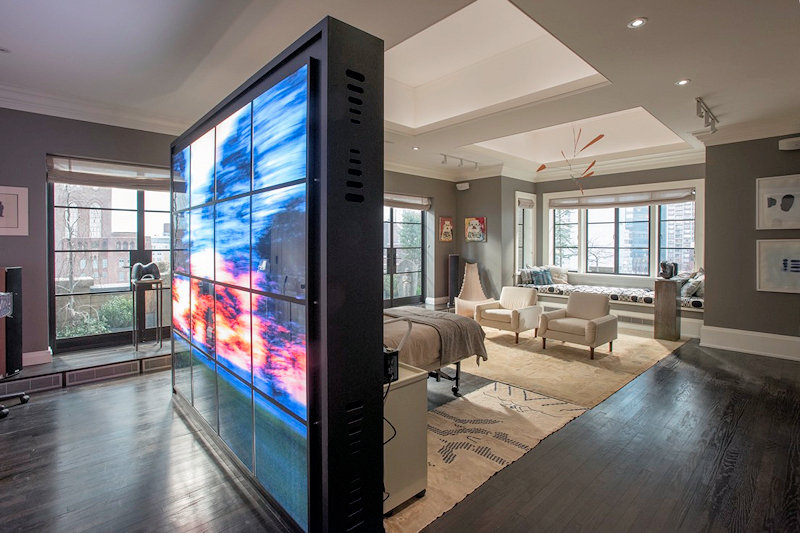
The mobile suspended in my shop before shipping it to the movie set in Philadelphia:
My custom-made Mobile 92 that served as inspiration for the design:
The art credits at the end of the movie:
A 3D “fly-around” animation of the computer model of the mobile:
From our local neighborhood newsletter:
Fan Artist Commissioned for Major Hollywood Film
By Katherine Jordan, Marco Mahler
In late 2016, Fan resident and kinetic sculptor Marco Mahler received a phone call from Alyssa Winter, who introduced herself as the assistant set decorator for a film under the working title Untouchable. She was interested in the possibility of having a large mobile sculpture custom created for the movie. Apparently much of the film was still in the early stages and yet to be decided, including members of the cast, but the fact that she had previously worked as set director for the television series Mr. Robot gave him an indication that this might be a major film.
They discussed the work of artists, such as Alexander Calder and Bruno Munari, the present copyright holders of their work, and possible implications of making and showing a mobile sculpture similar to theirs in a movie. Mahler sent some initial design ideas that she presented to the director of the movie, who turned out to be Neil Burger (who also directed Divergent, Limitless, and The Illusionist). They decided to commission Mahler for the mobile for the film and sent him a sketch of what they had in mind, modeled after an original work that he featured on his website. “The sketch they sent looked great, but the structure of it would never have worked as a mobile,” Marco Mahler remarked, “In a true mobile, the balance of the upper parts depends on the weight of the lower parts. If the sketch they sent would have been made as a mobile, the structure of it would have just collapsed.” Over the next month, they reworked the design, with him sending images and animations of new design variations to the set director Beth Rubino (IMDb) then sending back comments on the new designs from Neil Burger. By the end of January 2017, the design was finalized, and by mid-February, the mobile had been made and shipped to the movie set in Philadelphia, where the set crew installed it with the help of instructions that he sent along.
In the meantime, more details about the film emerged. The title of the film had been changed to The Upside, and Bryan Cranston, Kevin Hart, and Nicole Kidman were cast for the main characters. The film is a remake of the 2011 French film The Intouchables, which grossed over $400 million worldwide, making it the highest-grossing movie in a language other than English. Based on a real-life story and very similar to the original movie, The Upside follows a paralyzed billionaire (Bryan Cranston) who strikes up an unlikely friendship with a recently paroled convict (Kevin Hart). Marco Mahler added, “As I understood in the early stages of the movie when designing the mobile, I believe that Bryan Cranston’s character receives the mobile as a gift from his wife. After she passes away, the mobile becomes a symbol and reminder of their past love and marriage. Last I heard regarding the whereabouts of the mobile, Beth said they might display it at the premiere of the movie.”
The Upside is scheduled for release on January 11, 2019. In the meantime, you can see the mobile in the trailer for the movie and check-out more of Mahler’s work at www.marcomahler.com.
Custom dimensions for the mobile:
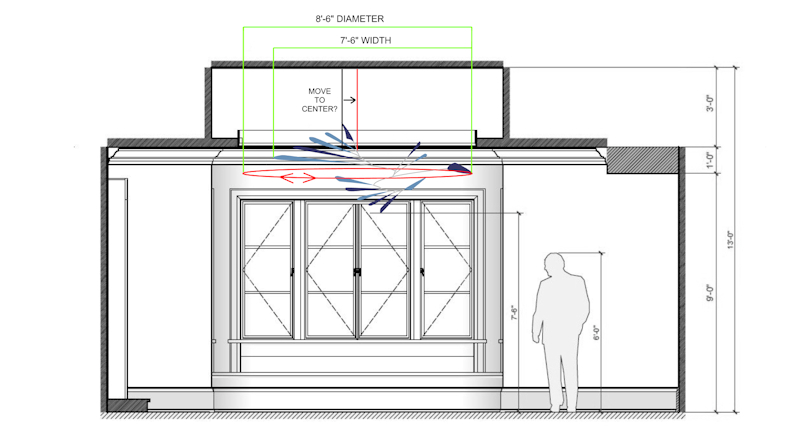
Additional ideas from the design process:
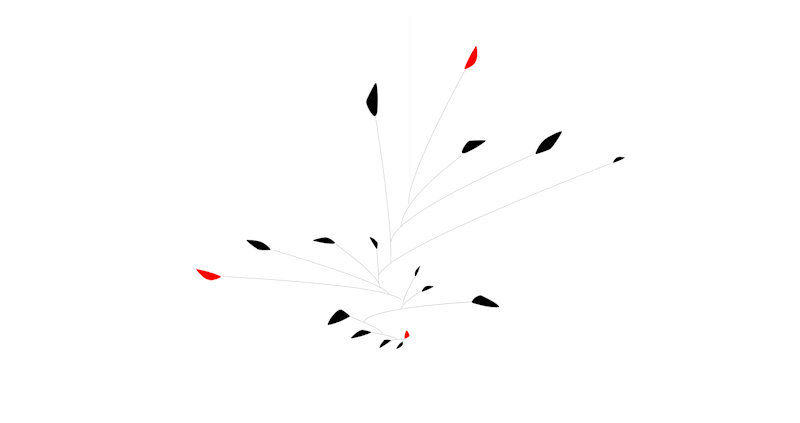







Mobile modeled after The Upside mobile made from a Dr. Pepper can by Jason L Nuttle:
Additional links:
“A penthouse apartment, a setting which is exploited to the fullest in this film, giant rooms with floor-to ceiling windows, vestibules, hallways, high ceilings, terraces, double-sink bathrooms, along with the Bryan Cranston character’s multimillion-dollar Contemporary Art collection, a million bucks worth of art hanging on every wall in every room of the place” – “The Upside” Is the Money
Movies and TV Shows Where Interior Design Is A Scene Stealer (featuring The Upside)
Movies and TV to Watch for the Interior Design (featuring The Upside)
Oct 23rd 2018 – The Upside premieres at Philadelphia Film Festival
Nov 2018 – Fan Artist Commissioned for Major Hollywood Film
Jan 13th 2019 – The Upside Tops Aquaman With Surprising $19.6M Weekend
Feb 27th 2019 – The Upside With Kevin Hart and Bryan Cranston Tops $100 Million Box Office
Artists whose artwork is also shown in the movie:
Rick Bartow
Helen Frankenthaler
Alex Katz
Lee Krasner
Saul Leiter
Robert Motherwell
Paul Bonet
Ed Ruscha
Kiki Smith
Cy Twombly
Robert Mapplethorpe
Edward Burtynsky
Joel Meyerowitz
Marilyn Minter
– See more of my custom designed mobile sculptures –

